Linking Fluorine with Bio-Derived Furfural: Aiming Towards More Sustainable Fluorinated Polymers and Drugs
Abstract
1. Introduction
2. Fluorination and Fluoroalkylation of Furfural-Derived Furans
2.1. Synthesis of Fluorofurans
2.2. Synthesis of Fluoroalkylfurans
 | ||||
| № | R | Reaction Conditions | Yield | Ref. |
| 1 | Me | CF3COOH, (4-ClPh)2SO (2 eq.), Ru(bpy)3Cl2 (1 mol. %), DCE, RT, 427 nm LED | 62 | [123] |
| 2 | Me | TFAA, Me2C=NOH (2 eq.), Ru(bpy)3Cl2, DCE, RT, 390 nm LED | 62 | [125] |
| 3 | OMe | CF3COOH, (4-ClPh)2SO (2 eq.), Ru(bpy)3Cl2 (1 mol. %), DCE, RT, 427 nm LED | 59 | [123] |
| 4 | OMe | TFAA, Me2C=NOH (2 eq.), Ru(bpy)3Cl2, DCE, RT, 390 nm LED | 74 | [125] |
| 5 | OMe | TFAA, Ir(ppy)3 (3 mol. %), EtOAc, 40 °C, 30 W blue LED | 64 | [124] |
| 6 | OMe | C6F5I(OCOCF3)2, Ru(bpy)3(PF6)2 (2 mol. %), CH3CN, 35 °C, blue LED | 41 | [105] |
| 7 | OMe | (CF3SO2)2O, Ru(bpy)3Cl2 (2 mol. %), pyridine, DCE, RT, LED | 74 | [43] |
| 8 | OMe | CF3SO2Na, [Ru(bpy)3][PF6]2, LiClO4, CH3CN, RT, blue LED, CCE at 4.0 mA | 77 | [130] |
| 9 | OMe | CF3SO2Cl, K2HPO4, 100 Hz, (+)C/(−)C, 4.8 V, CH3CN, 0.125 M LiClO4 | 32 | [131] |
| 10 | OC8H17 | CF3COOH, (4-ClPh)2SO (2 eq.), Ru(bpy)3Cl2 (1 mol. %), DCE, RT, 427 nm LED | 58 | [123] |
| 11 | OC8H17 | TFAA, Me2C=NOH (2 eq.), Ru(bpy)3Cl2, DCE, RT, 390 nm LED | 60 | [125] |
| 12 | NHMe | CF3SO2Na, [Ru(bpy)3][PF6]2, LiClO4, CH3CN, RT, blue LED, CCE at 4.0 mA | 69 | [130] |
| 13 | NH(CH2COOEt) | CF3SO2Na, [Ru(bpy)3][PF6]2, LiClO4, CH3CN, RT, blue LED, CCE at 4.0 mA | 70 | [130] |
| 14 | OH | TFAA, Me2C=NOH (2 eq.), Ru(bpy)3Cl2, DCE, RT, 390 nm LED | 68 | [125] |
| 15 | OH | (CF3SO2)2O, Ru(bpy)3Cl2 (2 mol. %), pyridine, DCE, RT, LED | 72 | [43] |
 | ||||
| № | R | Reaction Conditions | Yield | Ref. |
| 1 | CH3 | CF3SO2Cl, Ru-cat., Mg acetate, CH3CN, RT, blue light | 86 | [106] |
| 2 | CH3 | CF3SO2Cl, Ru(phen)3Cl2 (1 mol. %), K2HPO4, CH3CN, RT, 26 W light | 87 | [38] |
| 3 | CH3 | Co(III)-CF3 complex, NMP, RT, 16 W light | 87 | [127] |
| 4 | CH3 | CF3I, Ru(bpy)3Cl2 (1 mol. %), TMEDA, CH3CN, blue LED | 75 | [36] |
| 5 | CH3 | TMSCF3 (2eq.), PhI(OAc) (2 eq.), AgF (25 mol. %), DMSO, RT | 51 | [128] |
| 6 | CH3 |  , Ir(ppy)3 (2 mol.%), KBr, CH2Cl2, RT, blue LED , Ir(ppy)3 (2 mol.%), KBr, CH2Cl2, RT, blue LED | 63 | [132] |
| 7 | CH3 | CF3SO2Cl (2 eq.), K2HPO4, 100 Hz, (+)C/(−)C, CH3CN, 0.125 M LiClO4 | 43 | [131] |
| 8 | CH2S(CHO) | CF3SO2Cl, CdSe (10 mol. %), K2HPO4, CH3CN, RT, blue LED | 68 | [39] |
| 9 |  | TFAA, urea-hydrogen peroxide, CH2Cl2, 0 °C | 49 | [3] |
| 10 | CH2OBn | (C2F5CO)2O, urea-hydrogen peroxide, CH2Cl2, 0 °C | 46 | [3] |
| 11 |  | CF3COOH, XeF2, CH2Cl2, 0 → 20 °C, then H2O, CF3COOH | 30 1 | [133] |
| № | Furan | Reaction Conditions | Product | Yield | Ref. |
|---|---|---|---|---|---|
| 1 | Methyl 2-furoate | ICF2SO2F, [Ir(dFCF3ppy)2(bpy)]PF6 (1 mol. %), AgOTf (1 eq.), DMC, RT, blue LED |  | 80 | [138] |
| 2 | Methyl 2-furoate | BrCF2SO2(4-Cl-Ph), Mn2(CO)10 (10 mol. %), Davephos (15 mol. %), K2CO3, DCM, white LED |  | 86 | [139] |
| 3 | Methyl 2-furoate | BrCF2CO2Et, Pd(PPh3)4 (5 mol. %), Xantphos (10 mol. %), K2CO3, dioxane, Ar, 110 °C |  | 67 | [140] |
| 4 | Methyl 2-furoate | C3F7,XeF2, CH2Cl2, RT |  | 33 | [141] |
| 5 | Methyl 2-furoate | IC4F9 (30 eq.), CuI (10 mol. %), phen (20 mol. %), 2,4,6-collidine, CH2Cl2, 110 °C |  | 46 | [142] |
| 6 | Methyl 2-furoate | IC4F9, [Cu(bcp)DPEphos]PF6 (0.1 eq.), KOAc, CH2Cl2, blue LED |  | 51 | [143] |
| 7 | Methyl 2-furoate |  , Cu(OTf)2, CH3CN-H2O, 0 °C , Cu(OTf)2, CH3CN-H2O, 0 °C |  | 61 | [144] |
| 8 | Methyl 2-furoate | BrCF(CO2Et)2, fac-[Ir(ppy)3] (1mol. %), K2CO3, DMF, RT blue, LED |  | 72 | [145] |
| 9 |  | [Ph4P]+[Cu(CF2H)2]– (1 eq.), DMAc, 90 °C |  | 56 | [146] |
| 10 | Ethyl 2-furoate | BrCF2CN, [Ir(dtbbpy)(ppy)2][PF6], DMF, blue LED |  | 74 | [147] |
| 11 |  | [Ru(bpy)3]Cl2 6H2O (0.1 mol. %), NBu3 (1.5 eq.), HCOOH (1.5 eq.), DMSO, RT, blue LED |  | 73 | [148] |
| 12 |  |  (1.75 eq.), Pd(OAc)2 (5 mol. %), SIPr•Cl (10 mol. %), CuCl, Li2CO3, dioxane, 120 °C (1.75 eq.), Pd(OAc)2 (5 mol. %), SIPr•Cl (10 mol. %), CuCl, Li2CO3, dioxane, 120 °C |  | 50 | [149] |
| № | Furan | Reaction Conditions | Product | Yield | Ref. |
|---|---|---|---|---|---|
| 1 | Furfural | BrCF2CO2Et, CuI (10 mol. %), PMDETA (1.5 eq.), CH3CN, 80 °C |  | 50 | [154] |
| 2 | Furfural | BrCF2CO2Et, Ir(ppy)3 (0.5 mol. %), phen (20 mol. %), NaOAc (2 eq.), CH3CN, RT, 3 W blue LED |  | 44 | [155] |
| 3 | Furfural | BrCF2CO2Et, [Ru(p-cymene)Cl2]2 (5 mol. %), Na2CO3, AgTFA (2 eq.), N-Ac-L-Iso (30 mol. %), tert-butylamine (0.5 eq.), DCE, 155 °C |  | 62 | [156] |
| 4 |  | TMSCF2Br (7.2 eq.), CuBr (5.2 eq.), ArSH (12 eq.), phen, 18-crown-6, NaH, C6F6, NMP, 60 °C |  | 81 | [153] |
| 5 |  | TMSCF3 (1.8 eq.), C6F5TMS, CuCl (5.2 eq.), KF (12 eq.), 60 °C |  | 75 | [152] |
| 6 |  | (DMPU)2Zn(CHF2)2, (dppf)Ni(COD) (15 mol. %), DMSO, RT |  | 78 | [157] |
| 7 |  |  , Et2Zn (0.6 eq.), CuI (1.3 eq.), DMF, RT , Et2Zn (0.6 eq.), CuI (1.3 eq.), DMF, RT |  | 67 | [158] |
| 8 |  | Deoxo-Fluor (1.5 eq.) CH2Cl2, RT |  | 68 | [136] |
| 9 |  | BrCF2CO2Et, CuBr2 (10 mol. %), DTBDPy (10 mol. %), B2pin2 (30 mol. %), NaHCO3, dioxane, 80 °C |  | 51 | [159] |
| 10 |  |  (0.33 eq.), NaHCO3, CH3CN, RT, 462 nm LED (0.33 eq.), NaHCO3, CH3CN, RT, 462 nm LED |  | 69 | [160] |
| 11 | 2-Acetylfuran | BrCF2CO2Et, CuI (10 mol. %), PMDETA (1.5 eq.), CH3CN, 80 °C |  | 53 | [154] |
| 12 | 2-Acetylfuran | BrCF(CO2Et)2, fac-[Ir(ppy)3] (1mol. %), K2CO3, DMF, RT, blue LED |  | 65 | [145] |
| 13 | 2-Furonitrile | ICF2SO2F, [Ir(dFCF3ppy)2(bpy)]PF6 (1 mol. %), AgOTf (1 eq.), DMC, RT, blue LED |  | 85 | [138] |
| № | Furan | Reaction Conditions | Product | Yield | Ref. |
|---|---|---|---|---|---|
| 1 | 2-Methylfuran | BrCF2CO2Et, CuI (10 mol. %), K2CO3, DMF, 60 °C |  | 61 | [150] |
| 2 | 2-Methylfuran | BrCF2CO2Et, Pd(PPh3)4 (5 mol. %), Xantphos (10 mol. %), K2CO3, dioxane, Ar, 110 °C |  | 57 | [140] |
| 3 | 2-Ethylfuran | BrCF2CO2Et, fac-[Ir(ppy)3], K3PO4, DMF, RT, 7 W blue LED |  | 83 | [166] |
| 4 | 2-Ethylfuran | PhSO2CF2I, Pd2(dba)3 (5 mol. %), Xantphos (20 mol. %), Cs2CO3, CHCl3, 60 °C |  | 96 | [167] |
| 5 | 2-Ethylfuran | PhSO2CF2I, Ru(bpy)3Cl2•6H2O (1 mol. %), K2HPO4, CH2Cl2, 40 °C, 26W light |  | 96 | [168] |
| 6 | 2-Ethylfuran | BrCF2CO2Et, Pd(PPh3)4 (5 mol. %), Xantphos (10 mol. %), K2CO3, dioxane, Ar, 110 °C |  | 63 | [140] |
| 7 |  | PhSO2CF2I, Ru(bpy)3Cl2•6H2O (1 mol. %), K2HPO4, CH2Cl2, 26 W light, 40 °C |  | 90 | [168] |
| 8 |  | BrCF2CO2Et, Pd(PPh3)4 (5 mol. %), Xantphos (10 mol. %), K2CO3, dioxane, Ar, 110 °C |  | 80 | [167] |
| 9 | Furfuryl alcohol | IC4F9 (30 eq.), CuI (10 mol. %), 1,10 phenantroline (20 mol. %), 2,4,6-collidine, CH2Cl2, 110 °C |  | 74 | [142] |
| 10 |  | BrCF2CO2Et, CuI (10 mol. %), K2CO3, DMF, 80 °C |  | 64 | [150] |
| 11 |  | BrCF2CO2Et, CuI (10 mol. %), K2CO3, DMF, 80 °C |  | 65 | [150] |
| 12 |  | BrCF2CO2Et, CuI (10 mol. %), K2CO3, DMF, 80 °C |  | 63 | [150] |
| 13 |  | DAST (3.5 eq.), CH2Cl2, RT |  | 60 | [137] |
3. Application of Furfural-Derived Fluorofurans as Building Blocks in Drug Development
4. Conclusions
Author Contributions
Funding
Institutional Review Board Statement
Informed Consent Statement
Data Availability Statement
Acknowledgments
Conflicts of Interest
Abbreviations
| AIDS | Acquired immunodeficiency syndrome |
| BH3 | B-cell lymphoma homology 3 |
| bpy | 2,2′-Bipyridine |
| CAN | Covalent adaptable network |
| CCE | Constant current electrolysis |
| COD | 1,3-Cyclooctadiene |
| DA | Diels–Alder |
| DAST | Diethylaminosulfur trifluoride |
| dba | Dibenzylideneacetone |
| DCE | 1,2-Dichloroethane |
| Deoxo-Fluor | Bis(2-methoxyethyl)aminosulfur trifluoride |
| DIPEA | N,N-Diisopropylethylamine |
| DMC | Dimethyl carbonate |
| DMF | N,N-Dimethylformamide |
| DMPU | 1,3-Dimethyl-3,4,5,6-tetrahydro-2-pyrimidinone |
| DMSO | Dimethyl sulfoxide |
| dppBz | 1,2-Bis(diphenylphosphino)benzene |
| dppf | 1,1′-Bis(diphenylphosphino)ferrocene |
| DTBDPy | 4,4′-Di-tert-butyl-2,2′-dipyridyl |
| EDC | 1-Ethyl-3-(3-dimethylaminopropyl)carbodiimide |
| FDA | Food and Drug Administration |
| FMDA | Furan–maleimide Diels–Alder |
| HATU | Hexafluorophosphate azabenzotriazole tetramethyl uronium |
| HBTU | O-(benzotriazol-1-yl)-N,N,N,N-tetramethyluronium hexafluorophosphate |
| HIV | Human immunodeficiency virus |
| IC50 | Half maximal inhibitory concentration |
| LED | Light-emitting diode |
| MCL1 | Myeloid cell leukemia 1 |
| MIC | Minimum inhibitory concentration |
| MOM | Methoxymethyl |
| nAChR | α4β2 Nicotinic acetylcholine receptors |
| NMP | N-Methyl-2-pyrrolidone |
| phen | 1,10-Phenanthroline |
| PMDETA | N,N,N′,N″,N″-Pentamethyldiethylenetriamine |
| PPARγ | Peroxisome proliferator-activated receptor gamma |
| ppy | 2-Phenylpyridine |
| rDA | Retro Diels–Alder |
| RT | Room temperature |
| SAR | Structure—activity relationship |
| SelectFluor | 1-(Chloromethyl)-4-fluoro-1,4-diazabicyclo [2.2.2]octane-1,4-diium ditetrafluoroborate |
| SET | Single electron transfer |
| SIPr•Cl | 1,3-Bis [2,6-bis(1-methylethyl) phenyl]-1H-imidazolium chloride |
| TEA | Triethylamine |
| TFA | Trifluoroacetic acid |
| TFAA | Trifluoroacetic anhydride |
| THF | Tetrahydrofuran |
| TMEDA | Tetramethylethylenediamine |
References
- Budisa, N.; Kubyshkin, V.; Schulze-Makuch, D. Fluorine-rich planetary environments as possible habitats for life. Life 2014, 4, 374–385. [Google Scholar] [CrossRef] [PubMed]
- Ismail, F.M.D. Important fluorinated drugs in experimental and clinical use. J. Fluorine Chem. 2002, 118, 27–33. [Google Scholar] [CrossRef]
- Zhong, S.; Hafner, A.; Hussal, C.; Nieger, M.; Bräse, S. Metal-free radical perfluoroalkylation of (hetero)arenes. RSC Adv. 2015, 5, 6255–6258. [Google Scholar] [CrossRef]
- Rizzo, C.; Amata, S.; Pibiri, I.; Pace, A.; Buscemi, S.; Palumbo Piccionello, A. FDA-Approved Fluorinated Heterocyclic Drugs from 2016 to 2022. Int. J. Mol. Sci. 2023, 24, 7728. [Google Scholar] [CrossRef]
- Han, J.; Kiss, L.; Mei, H.; Remete, A.M.; Ponikvar-Svet, M.; Sedgwick, D.M.; Roman, R.; Fustero, S.; Moriwaki, H.; Soloshonok, V.A. Chemical Aspects of Human and Environmental Overload with Fluorine. Chem. Rev. 2021, 121, 4678–4742. [Google Scholar] [CrossRef]
- Gillis, E.P.; Eastman, K.J.; Hill, M.D.; Donnelly, D.J.; Meanwell, N.A. Applications of Fluorine in Medicinal Chemistry. J. Med. Chem. 2015, 58, 8315–8359. [Google Scholar] [CrossRef] [PubMed]
- Shah, P.; Westwell, A.D. The role of fluorine in medicinal chemistry. J. Enzyme Inhib. Med. Chem. 2007, 22, 527–540. [Google Scholar] [CrossRef] [PubMed]
- Bohm, H.J.; Banner, D.; Bendels, S.; Kansy, M.; Kuhn, B.; Muller, K.; Obst-Sander, U.; Stahl, M. Fluorine in medicinal chemistry. ChemBioChem 2004, 5, 637–643. [Google Scholar] [CrossRef]
- Niu, Z.X.; Hu, J.; Sun, J.F.; Wang, Y.T. Fluorine in the pharmaceutical industry: Synthetic approaches and application of clinically approved fluorine-enriched anti-infectious medications. Eur. J. Med. Chem. 2024, 271, 116446. [Google Scholar] [CrossRef]
- Moskalik, M.Y. Monofluoromethylation of N-Heterocyclic Compounds. Int. J. Mol. Sci. 2023, 24, 17593. [Google Scholar] [CrossRef]
- Zhou, Y.; Wang, J.; Gu, Z.; Wang, S.; Zhu, W.; Acena, J.L.; Soloshonok, V.A.; Izawa, K.; Liu, H. Next Generation of Fluorine-Containing Pharmaceuticals, Compounds Currently in Phase II-III Clinical Trials of Major Pharmaceutical Companies: New Structural Trends and Therapeutic Areas. Chem. Rev. 2016, 116, 422–518. [Google Scholar] [CrossRef] [PubMed]
- Jeschke, P. Recent developments in fluorine-containing pesticides. Pest Manag. Sci. 2024, 80, 3065–3087. [Google Scholar] [CrossRef]
- Grygorenko, O.O.; Melnykov, K.P.; Holovach, S.; Demchuk, O. Fluorinated Cycloalkyl Building Blocks for Drug Discovery. ChemMedChem 2022, 17, e202200365. [Google Scholar] [CrossRef]
- Mao, T.; Ma, M.J.; Zhao, L.; Xue, D.P.; Yu, Y.; Gu, J.; He, C.Y. A general and green fluoroalkylation reaction promoted via noncovalent interactions between acetone and fluoroalkyl iodides. Chem. Commun. 2020, 56, 1815–1818. [Google Scholar] [CrossRef]
- Meanwell, N.A. Fluorine and Fluorinated Motifs in the Design and Application of Bioisosteres for Drug Design. J. Med. Chem. 2018, 61, 5822–5880. [Google Scholar] [CrossRef] [PubMed]
- Wang, J.; Sanchez-Rosello, M.; Acena, J.L.; del Pozo, C.; Sorochinsky, A.E.; Fustero, S.; Soloshonok, V.A.; Liu, H. Fluorine in pharmaceutical industry: Fluorine-containing drugs introduced to the market in the last decade (2001–2011). Chem. Rev. 2014, 114, 2432–2506. [Google Scholar] [CrossRef]
- Purser, S.; Moore, P.R.; Swallow, S.; Gouverneur, V. Fluorine in medicinal chemistry. Chem. Soc. Rev. 2008, 37, 320–330. [Google Scholar] [CrossRef] [PubMed]
- Burger, K.; Helmreich, B.; Jendrewski, O.; Hecht, R.; Maier, G.; Nuyken, O. New strategies for synthesis of partially fluorinated heterocycles as precursors for trifluoromethyl-substituted polymers. Macromol. Symp. 2011, 82, 143–160. [Google Scholar] [CrossRef]
- Jeanmart, S.; Edmunds, A.J.F.; Lamberth, C.; Pouliot, M.; Morris, J.A. Synthetic Approaches to the 2019–2020 New Agrochemicals. Synthesis 2023, 56, 357–367. [Google Scholar] [CrossRef]
- Ali, S.; Zhou, J. Highlights on U.S. FDA-approved fluorinated drugs over the past five years (2018–2022). Eur. J. Med. Chem. 2023, 256, 115476. [Google Scholar] [CrossRef]
- Wang, Q.; Song, H.; Wang, Q. Fluorine-containing agrochemicals in the last decade and approaches for fluorine incorporation. Chin. Chem. Lett. 2022, 33, 626–642. [Google Scholar] [CrossRef]
- Hong, C.M.; Whittaker, A.M.; Schultz, D.M. Nucleophilic Fluorination of Heteroaryl Chlorides and Aryl Triflates Enabled by Cooperative Catalysis. J. Org. Chem. 2021, 86, 3999–4006. [Google Scholar] [CrossRef] [PubMed]
- Ogawa, Y.; Tokunaga, E.; Kobayashi, O.; Hirai, K.; Shibata, N. Current Contributions of Organofluorine Compounds to the Agrochemical Industry. iScience 2020, 23, 101467. [Google Scholar] [CrossRef] [PubMed]
- Inoue, M.; Sumii, Y.; Shibata, N. Contribution of Organofluorine Compounds to Pharmaceuticals. ACS Omega 2020, 5, 10633–10640. [Google Scholar] [CrossRef] [PubMed]
- Champagne, P.A.; Desroches, J.; Hamel, J.D.; Vandamme, M.; Paquin, J.F. Monofluorination of Organic Compounds: 10 Years of Innovation. Chem. Rev. 2015, 115, 9073–9174. [Google Scholar] [CrossRef]
- Nosova, E.V.; Lipunova, G.N.; Charushin, V.N.; Chupakhin, O.N. Fluorine-containing indoles: Synthesis and biological activity. J. Fluorine Chem. 2018, 212, 51–106. [Google Scholar] [CrossRef]
- Budovská, M.; Krochtová, K.; Kuba, M.; Tischlerová, V.; Mojžiš, J. Synthesis and cytotoxicity evaluation of novel 5-fluorinated indoles. J. Fluorine Chem. 2021, 250, 109879. [Google Scholar] [CrossRef]
- Zayed, M.F. New fluorinated quinazolinone derivatives as anticonvulsant agents. J. Taibah Univ. Med. Sci. 2014, 9, 104–109. [Google Scholar] [CrossRef]
- Balakumar, C.; Lamba, P.; Kishore, D.P.; Narayana, B.L.; Rao, K.V.; Rajwinder, K.; Rao, A.R.; Shireesha, B.; Narsaiah, B. Synthesis, anti-inflammatory evaluation and docking studies of some new fluorinated fused quinazolines. Eur. J. Med. Chem. 2010, 45, 4904–4913. [Google Scholar] [CrossRef]
- Jasem, Y.A.; Thiemann, T.; Gano, L.; Oliveira, M.C. Fluorinated steroids and their derivatives. J. Fluorine Chem. 2016, 185, 48–85. [Google Scholar] [CrossRef]
- Sandulenko, I.V.; Ambartsumyan, A.A.; Moiseev, S.K. Fluorinated and [(18)F]fluorinated morphinan based opioid ligands. Org. Biomol. Chem. 2020, 18, 5533–5557. [Google Scholar] [CrossRef] [PubMed]
- Sandulenko, I.V.; Belozertseva, I.V.; Zvartau, E.E.; Zelentsova, M.V.; Ambartsumyan, A.A.; Smol’yakov, A.F.; Moiseev, S.K. C(21)-fluorinated thevinol scaffold for opioid ligands. 21,21,21-Trifluoro-6-O-nororvinols: Design, synthesis and analgesic activity. Eur. J. Med. Chem. 2023, 252, 115296. [Google Scholar] [CrossRef] [PubMed]
- Ambartsumyan, A.A.; Belozertseva, I.V.; Dravolina Ocapital, A.C.; Zvartau, E.E.; Sandulenko, I.V.; Zelentsova, M.V.; Peregudov, A.S.; Moiseev, S.K. Orvinol-based opioid receptor antagonist fluorinated at C(20)-pharmacophore. Eur. J. Med. Chem. 2025, 284, 117189. [Google Scholar] [CrossRef] [PubMed]
- Liu, Y.; Tian, Q.; Ge, J.; Wu, X.; Li, Z.; Cheng, G. Recent advances in the synthesis of trifluoromethyl-containing heterocyclic compounds via trifluoromethyl building blocks. Org. Biomol. Chem. 2024, 22, 6246–6276. [Google Scholar] [CrossRef]
- Burger, K.; Helmreich, B.; Hennig, L.; Spengler, J.; Albericio, F.; Fuchs, A. Partially Fluorinated Heterocycles from 4,4-Bis(trifluoromethyl)-hetero-1,3-dienes via C–F Bond Activation—Synthesis of 2-Fluoro-3-(trifluoromethyl)furans. Monatsh. Chem. 2007, 138, 227–236. [Google Scholar] [CrossRef]
- Straathof, N.J.; Gemoets, H.P.; Wang, X.; Schouten, J.C.; Hessel, V.; Noel, T. Rapid trifluoromethylation and perfluoroalkylation of five-membered heterocycles by photoredox catalysis in continuous flow. ChemSusChem 2014, 7, 1612–1617. [Google Scholar] [CrossRef]
- Liang, T.; Neumann, C.N.; Ritter, T. Introduction of fluorine and fluorine-containing functional groups. Angew. Chem. Int. Ed. 2013, 52, 8214–8264. [Google Scholar] [CrossRef]
- Nagib, D.A.; MacMillan, D.W. Trifluoromethylation of arenes and heteroarenes by means of photoredox catalysis. Nature 2011, 480, 224–228. [Google Scholar] [CrossRef]
- Muralirajan, K.; Kancherla, R.; Bau, J.A.; Taksande, M.R.; Qureshi, M.; Takanabe, K.; Rueping, M. Exploring the Structure and Performance of Cd–Chalcogenide Photocatalysts in Selective Trifluoromethylation. ACS Catal. 2021, 11, 14772–14780. [Google Scholar] [CrossRef]
- Shaw, R.; Sihag, N.; Bhartiya, H.; Yadav, M.R. Harnessing photocatalytic and electrochemical approaches for C–H bond trifluoromethylation and fluoroalkylation. Org. Chem. Front. 2024, 11, 954–1014. [Google Scholar] [CrossRef]
- Baishya, G.; Dutta, N.B. Recent Advances in Direct C−H Trifluoromethylation of N-Heterocycles. ChemistrySelect 2021, 6, 13384–13408. [Google Scholar] [CrossRef]
- Mandal, D.; Maji, S.; Pal, T.; Sinha, S.K.; Maiti, D. Recent advances in transition metal-mediated trifluoromethylation reactions. Chem. Commun. 2022, 58, 10442–10468. [Google Scholar] [CrossRef] [PubMed]
- Ouyang, Y.; Xu, X.H.; Qing, F.L. Trifluoromethanesulfonic Anhydride as a Low-Cost and Versatile Trifluoromethylation Reagent. Angew. Chem. Int. Ed. 2018, 57, 6926–6929. [Google Scholar] [CrossRef] [PubMed]
- Xiao, H.; Zhang, Z.; Fang, Y.; Zhu, L.; Li, C. Radical trifluoromethylation. Chem. Soc. Rev. 2021, 50, 6308–6319. [Google Scholar] [CrossRef] [PubMed]
- O’Hagan, D.; Young, R.J. Future challenges and opportunities with fluorine in drugs? Med. Chem. Res. 2023, 32, 1231–1234. [Google Scholar] [CrossRef]
- Sham, H.L.; Betebenner, D.A. A new and concise synthesis of 3-fluoro-2,5-disubstituted furans. J. Chem. Soc. Chem. Commun. 1991, 16, 1134–1135. [Google Scholar] [CrossRef]
- Kushwaha, P.; Rashi, R.; Bhardwaj, A.; Khan, D. Advances in Synthesis and Anti-Alzheimer’s Disease Potential of Functionalized Benzofurans: A Recent Overview. Synlett 2025. [Google Scholar] [CrossRef]
- Patel, P.; Shakya, R.; Vishakha; Asati, V.; Kurmi, B.D.; Verma, S.K.; Gupta, G.D.; Rajak, H. Furan and benzofuran derivatives as privileged scaffolds as anticancer agents: SAR and docking studies (2010 to till date). J. Mol. Struct. 2024, 1299, 137098. [Google Scholar] [CrossRef]
- Arce-Ramos, L.; Castillo, J.C.; Becerra, D. Synthesis and Biological Studies of Benzo[b]furan Derivatives: A Review from 2011 to 2022. Pharmaceuticals 2023, 16, 1265. [Google Scholar] [CrossRef]
- Banerjee, R.; Hks, K.; Banerjee, M. Medicinal significance of furan derivatives: A Review. Int. J. Res. Phytochem. Pharmacol. 2015, 5, 48–57. [Google Scholar]
- Nevagi, R.J.; Dighe, S.N.; Dighe, S.N. Biological and medicinal significance of benzofuran. Eur. J. Med. Chem. 2015, 97, 561–581. [Google Scholar] [CrossRef] [PubMed]
- Chen, V.Y.; Kwon, O. Unified Approach to Furan Natural Products via Phosphine-Palladium Catalysis. Angew. Chem. Int. Ed. 2021, 60, 8874–8881. [Google Scholar] [CrossRef] [PubMed]
- Galkin, K.I.; Ananikov, V.P. When Will 5-Hydroxymethylfurfural, the "Sleeping Giant" of Sustainable Chemistry, Awaken? ChemSusChem 2019, 12, 2976–2982. [Google Scholar] [CrossRef]
- Galkin, K.I.; Krivodaeva, E.A.; Romashov, L.V.; Zalesskiy, S.S.; Kachala, V.V.; Burykina, J.V.; Ananikov, V.P. Critical Influence of 5-Hydroxymethylfurfural Aging and Decomposition on the Utility of Biomass Conversion in Organic Synthesis. Angew. Chem. Int. Ed. 2016, 55, 8338–8342. [Google Scholar] [CrossRef] [PubMed]
- Kolykhalov, D.A.; Golysheva, A.N.; Erokhin, K.S.; Karlinskii, B.Y.; Ananikov, V.P. The Stability Challenge of Furanic Platform Chemicals in Acidic and Basic Conditions. ChemSusChem 2025, 18, e202401849. [Google Scholar] [CrossRef]
- Placais, C.; Donnard, M.; Panossian, A.; Vors, J.P.; Bernier, D.; Pazenok, S.; Leroux, F.R. Synthesis of 3-Amino-5-fluoroalkylfurans by Intramolecular Cyclization. Org. Lett. 2021, 23, 4915–4919. [Google Scholar] [CrossRef]
- Wang, J.; Chen, S.; Wu, W.; Wen, S.; Weng, Z. Base-Mediated Tunable Synthesis of 2-Trifluoromethylated Furans and Dihydrofuranols: Extraordinary Stable in Sulfuric Acid. J. Org. Chem. 2019, 84, 15685–15696. [Google Scholar] [CrossRef] [PubMed]
- Taj, M.B.; Raheel, A.; Ayub, R.; Alnajeebi, A.M.; Abualnaja, M.; Habib, A.H.; Alelwani, W.; Noor, S.; Ullah, S.; Al-Sehemi, A.G.; et al. Exploring novel fluorine-rich fuberidazole derivatives as hypoxic cancer inhibitors: Design, synthesis, pharmacokinetics, molecular docking, and DFT evaluations. PLoS ONE 2023, 18, e0262790. [Google Scholar] [CrossRef]
- Zhou, W.; Yue, Z.; Zhang, J. A highly efficient one-pot trifluoromethylation/cyclization reaction of electron-deficient 1,3-conjugated enynes: Modular access to trifluoromethylated furans and 2,3-dihydrofurans. Org. Chem. Front. 2016, 3, 1416–1419. [Google Scholar] [CrossRef]
- Chong, Q.; Xin, X.; Wang, C.; Wu, F.; Wang, H.; Shi, J.C.; Wan, B. DABCO-catalyzed synthesis of trifluoromethylated furans from propargyl alcohols and methyl 2-perfluoroalkynoate. J. Org. Chem. 2014, 79, 2105–2110. [Google Scholar] [CrossRef]
- Sun, Y.; Yang, H.; Yuan, J.; Wang, L.; Song, S.; Chen, R.; Bao, X.; Jia, L.; Yang, T.; Zhang, X.; et al. YCH1899, a Highly Effective Phthalazin-1(2H)-one Derivative That Overcomes Resistance to Prior PARP Inhibitors. J. Med. Chem. 2023, 66, 12284–12303. [Google Scholar] [CrossRef] [PubMed]
- Abbas, A.A.; Farghaly, T.A.; Dawood, K.M. Recent advances on anticancer and antimicrobial activities of directly-fluorinated five-membered heterocycles and their benzo-fused systems. RSC Adv. 2024, 14, 19752–19779. [Google Scholar] [CrossRef]
- Abbas, A.A.; Farghaly, T.A.; Dawood, K.M. Recent progress in therapeutic applications of fluorinated five-membered heterocycles and their benzo-fused systems. RSC Adv. 2024, 14, 33864–33905. [Google Scholar] [CrossRef]
- Cantrell, A.S.; Engelhardt, P.; Hogberg, M.; Jaskunas, S.R.; Johansson, N.G.; Jordan, C.L.; Kangasmetsa, J.; Kinnick, M.D.; Lind, P.; Morin, J.M., Jr.; et al. Phenethylthiazolylthiourea (PETT) compounds as a new class of HIV-1 reverse transcriptase inhibitors. 2. Synthesis and further structure-activity relationship studies of PETT analogs. J. Med. Chem. 1996, 39, 4261–4274. [Google Scholar] [CrossRef] [PubMed]
- Kotschy, A.; Szlavik, Z.; Murray, J.; Davidson, J.; Maragno, A.L.; Le Toumelin-Braizat, G.; Chanrion, M.; Kelly, G.L.; Gong, J.N.; Moujalled, D.M.; et al. The MCL1 inhibitor S63845 is tolerable and effective in diverse cancer models. Nature 2016, 538, 477–482. [Google Scholar] [CrossRef]
- Li, M.; Zhou, W. Transition-Metal-Free Synthesis of Trifluoromethylated Furans via a Bu3P-Mediated Tandem Acylation–Wittig Reaction. Synlett 2020, 31, 2035–2038. [Google Scholar] [CrossRef]
- Xu, W.; Zhang, Q.; Shao, Q.; Xia, C.; Wu, M. Photocatalytic C−F Bond Activation of Fluoroarenes, gem-Difluoroalkenes and Trifluoromethylarenes. Asian J. Org. Chem. 2021, 10, 2454–2472. [Google Scholar] [CrossRef]
- Hooker, L.V.; Bandar, J.S. Synthetic Advantages of Defluorinative C-F Bond Functionalization. Angew. Chem. Int. Ed. 2023, 62, e202308880. [Google Scholar] [CrossRef]
- Simur, T.T.; Ye, T.; Yu, Y.-J.; Zhang, F.-L.; Wang, Y.-F. C–F bond functionalizations of trifluoromethyl groups via radical intermediates. Chin. Chem. Lett. 2022, 33, 1193–1198. [Google Scholar] [CrossRef]
- Burger, K.; Helmreich, B. Synthesis of 3-trifluoromethylfurans from β,β-bis(trifluoromethyl)α,β-unsaturated ketones and tin(II) chloride. J. Chem. Soc. Chem. Commun. 1992, 4, 348–349. [Google Scholar] [CrossRef]
- Li, P.; Chai, Z.; Zhao, G.; Zhu, S.-Z. Synthesis of 3-Fluoro-2,5-Disubstituted Furans and Further Derivative Reactions to Access Fluorine-Containing 3,3′-Bifurans and Tetrasubstituted Furans. Synlett 2008, 2008, 2547–2551. [Google Scholar] [CrossRef]
- Li, Y.; Wheeler, K.A.; Dembinski, R. Room temperature syntheses of entirely diverse substituted beta-fluorofurans. Org. Biomol. Chem. 2012, 10, 2395–2408. [Google Scholar] [CrossRef][Green Version]
- Burger, K.; Hennig, L.; Fuchs, A.; Greif, D.; Spengler, J.; Albericio, F. Domino Reactions with Fluorinated Five-membered Heterocycles—Syntheses of Trifluoromethyl Substituted Butenolides and γ-Ketoacids. Monatsh. Chem. 2005, 136, 1763–1779. [Google Scholar] [CrossRef]
- Xu, C.; Paone, E.; Rodriguez-Padron, D.; Luque, R.; Mauriello, F. Recent catalytic routes for the preparation and the upgrading of biomass derived furfural and 5-hydroxymethylfurfural. Chem. Soc. Rev. 2020, 49, 4273–4306. [Google Scholar] [CrossRef]
- Li, X.; Jia, P.; Wang, T. Furfural: A Promising Platform Compound for Sustainable Production of C4 and C5 Chemicals. ACS Catal. 2016, 6, 7621–7640. [Google Scholar] [CrossRef]
- Mori, A.; Curpanen, S.; Pezzetta, C.; Perez-Luna, A.; Poli, G.; Oble, J. C−H Activation Based Functionalization of Furfural Derivatives. Eur. J. Org. Chem. 2022, 2022, e202200727. [Google Scholar] [CrossRef]
- Bozell, J.J.; Petersen, G.R. Technology development for the production of biobased products from biorefinery carbohydrates—The US Department of Energy’s “Top 10” revisited. Green Chem. 2010, 12, 539. [Google Scholar] [CrossRef]
- Song, R.; Lin, W.; Jiang, Q. A convenient synthesis of 5-fluorofuran-2-carboxylic acid. Tetrahedron Lett. 2011, 52, 4965–4966. [Google Scholar] [CrossRef]
- Gandini, A. The furan/maleimide Diels–Alder reaction: A versatile click–unclick tool in macromolecular synthesis. Prog. Polym. Sci. 2013, 38, 1–29. [Google Scholar] [CrossRef]
- Gevrek, T.N.; Sanyal, A. Furan-containing polymeric Materials: Harnessing the Diels-Alder chemistry for biomedical applications. Eur. Polym. J. 2021, 153, 110514. [Google Scholar] [CrossRef]
- Kucherov, F.A.; Romashov, L.V.; Galkin, K.I.; Ananikov, V.P. Chemical Transformations of Biomass-Derived C6-Furanic Platform Chemicals for Sustainable Energy Research, Materials Science, and Synthetic Building Blocks. ACS Sustain. Chem. Eng. 2018, 6, 8064–8092. [Google Scholar] [CrossRef]
- Espro, C.; Paone, E.; Mauriello, F.; Gotti, R.; Uliassi, E.; Bolognesi, M.L.; Rodriguez-Padron, D.; Luque, R. Sustainable production of pharmaceutical, nutraceutical and bioactive compounds from biomass and waste. Chem. Soc. Rev. 2021, 50, 11191–11207. [Google Scholar] [CrossRef]
- Luque, R.; ZA, A.L.; Balu, A.M.; Voskressensky, L. Heterogeneous Catalysis to Drive the Waste-to-Pharma Concept: From Furanics to Active Pharmaceutical Ingredients. Molecules 2021, 26, 6738. [Google Scholar] [CrossRef]
- Galkin, K.I.; Sandulenko, I.V.; Polezhaev, A.V. Diels–Alder Cycloadditions of Bio-Derived Furans with Maleimides as a Sustainable «Click» Approach towards Molecular, Macromolecular and Hybrid Systems. Processes 2022, 10, 30. [Google Scholar] [CrossRef]
- Briou, B.; Améduri, B.; Boutevin, B. Trends in the Diels–Alder reaction in polymer chemistry. Chem. Soc. Rev. 2021, 50, 11055–11097. [Google Scholar] [CrossRef] [PubMed]
- Chen, X.; Dam, M.A.; Ono, K.; Mal, A.; Shen, H.; Nutt, S.R.; Sheran, K.; Wudl, F. A thermally re-mendable cross-linked polymeric material. Science 2002, 295, 1698–1702. [Google Scholar] [CrossRef]
- Scheutz, G.M.; Lessard, J.J.; Sims, M.B.; Sumerlin, B.S. Adaptable Crosslinks in Polymeric Materials: Resolving the Intersection of Thermoplastics and Thermosets. J. Am. Chem. Soc. 2019, 141, 16181–16196. [Google Scholar] [CrossRef]
- Lucherelli, M.A.; Duval, A.; Avérous, L. Biobased vitrimers: Towards sustainable and adaptable performing polymer materials. Prog. Polym. Sci. 2022, 127, 101515. [Google Scholar] [CrossRef]
- Mariani, A.; Malucelli, G. Biobased vitrimers: Towards sustainability and circularity. Chem. Commun. 2025, 61, 2173–2189. [Google Scholar] [CrossRef]
- Purushotam; Bera, A.; Banerjee, D. Recent advances on non-precious metal-catalysed fluorination, difluoromethylation, trifluoromethylation, and perfluoroalkylation of N-heteroarenes. Org. Biomol. Chem. 2023, 21, 9298–9315. [Google Scholar] [CrossRef]
- Alonso, C.; Martinez de Marigorta, E.; Rubiales, G.; Palacios, F. Carbon trifluoromethylation reactions of hydrocarbon derivatives and heteroarenes. Chem. Rev. 2015, 115, 1847–1935. [Google Scholar] [CrossRef] [PubMed]
- Kliś, T. Visible-Light Photoredox Catalysis for the Synthesis of Fluorinated Aromatic Compounds. Catalysts 2023, 13, 94. [Google Scholar] [CrossRef]
- O’Leary, E.M.; Jones, D.J.; O’Donovan, F.P.; O’Sullivan, T.P. Synthesis of fluorinated oxygen- and sulfur-containing heteroaromatics. J. Fluorine Chem. 2015, 176, 93–120. [Google Scholar] [CrossRef]
- Serdyuk, O.; Butin, A.; Abaev, V. Synthesis of fluorofurans and perfluoroalkylfurans. J. Fluorine Chem. 2010, 131, 296–319. [Google Scholar] [CrossRef]
- Kondratov, I.S.; Tolmachova, N.A.; Haufe, G. Diels–Alder Reaction in the Synthesis of Fluorinated (Hetero)Aromatic Compounds. Eur. J. Org. Chem. 2018, 2018, 3618–3647. [Google Scholar] [CrossRef]
- Nyffeler, P.T.; Duron, S.G.; Burkart, M.D.; Vincent, S.P.; Wong, C.H. Selectfluor: Mechanistic insight and applications. Angew. Chem. Int. Ed. 2004, 44, 192–212. [Google Scholar] [CrossRef]
- Alic, B.; Petrovcic, J.; Jelen, J.; Tavcar, G.; Iskra, J. Renewable Reagent for Nucleophilic Fluorination. J. Org. Chem. 2022, 87, 5987–5993. [Google Scholar] [CrossRef]
- Campbell, M.G.; Ritter, T. Modern carbon-fluorine bond forming reactions for aryl fluoride synthesis. Chem. Rev. 2015, 115, 612–633. [Google Scholar] [CrossRef]
- Yerien, D.E.; Bonesi, S.; Postigo, A. Fluorination methods in drug discovery. Org. Biomol. Chem. 2016, 14, 8398–8427. [Google Scholar] [CrossRef]
- Fernandes, A.J.; Giri, R.; Houk, K.N.; Katayev, D. Review and Theoretical Analysis of Fluorinated Radicals in Direct C(Ar)-H Functionalization of (Hetero)arenes. Angew. Chem. Int. Ed. 2024, 63, e202318377. [Google Scholar] [CrossRef]
- Jin, Z.; Zhang, F.; Xiao, X.; Wang, N.; Lv, X.; Zhou, L. Recent advances in N-heterocyclic carbene (NHC)-catalyzed fluorination and fluoroalkylation. Org. Chem. Front. 2024, 11, 2112–2133. [Google Scholar] [CrossRef]
- Yang, L.; Dong, T.; Revankar, H.M.; Zhang, C.-P. Recent progress on fluorination in aqueous media. Green Chem. 2017, 19, 3951–3992. [Google Scholar] [CrossRef]
- Britton, R.; Gouverneur, V.; Lin, J.-H.; Meanwell, M.; Ni, C.; Pupo, G.; Xiao, J.-C.; Hu, J. Contemporary synthetic strategies in organofluorine chemistry. Nat. Rev. Methods Primers 2021, 1, 47. [Google Scholar] [CrossRef]
- Bui, T.T.; Hong, W.P.; Kim, H.-K. Recent Advances in Visible Light-mediated Fluorination. J. Fluorine Chem. 2021, 247, 109794. [Google Scholar] [CrossRef]
- Yang, B.; Yu, D.; Xu, X.-H.; Qing, F.-L. Visible-Light Photoredox Decarboxylation of Perfluoroarene Iodine(III) Trifluoroacetates for C–H Trifluoromethylation of (Hetero)arenes. ACS Catal. 2018, 8, 2839–2843. [Google Scholar] [CrossRef]
- Lemmens, V.; Vos, C.; Bugaev, A.L.; Vercammen, J.; Van Velthoven, N.; Gascon, J.; De Vos, D.E. Ru-Bipyridine Entrapped in the Supercages of EMC-1 Faujasite as Catalyst for the Trifluoromethylation of Arenes. ACS Appl. Mater. Interfaces 2022, 14, 971–977. [Google Scholar] [CrossRef]
- Gandini, A.; Lacerda, T.M. Furan Polymers: State of the Art and Perspectives. Macromol. Mater. Eng. 2022, 307, 2100902. [Google Scholar] [CrossRef]
- Iroegbu, A.O.C.; Ray, S.S. On the chemistry of furfuryl alcohol polymerization: A review. J. Polym. Sci. 2023, 62, 1044–1060. [Google Scholar] [CrossRef]
- Yang, X.; Fang, X.; Shao, T. One-Pot Synthesis of α-Fluoroketones and 3-Fluoro-2,4-diarylfurans from Trifluoromethyl β-Diketones via Decarboxylation. Synlett 2015, 26, 1835–1840. [Google Scholar] [CrossRef]
- Panferova, L.I.; Tsymbal, A.V.; Levin, V.V.; Struchkova, M.I.; Dilman, A.D. Reactions of gem-Difluorinated Phosphonium Salts Induced by Light. Org. Lett. 2016, 18, 996–999. [Google Scholar] [CrossRef]
- Yamamoto, Y.; Kuroyanagi, E.; Suzuki, H.; Yasui, T. Catalyst-Free Csp−Csp3 Cross-Coupling of Bromodifluoroacetamides with 1-Iodoalkynes under Visible-Light Irradiation. Adv. Synth. Catal. 2021, 363, 4932–4940. [Google Scholar] [CrossRef]
- Miyazaki, D.; Kudo, K.; Fujiki, Y.; Watanabe, N.; Matsui, T.; Ichikawa, J.; Fuchibe, K. Gold(I)-Catalyzed [2 + 2] and [3 + 2] Cycloadditions of 1,1-Difluoroallenes with Aldehydes: Switchable Syntheses of Fluorinated Oxetanes and Furans. Org. Lett. 2025, 27, 3807–3812. [Google Scholar] [CrossRef] [PubMed]
- Sugiishi, T.; Matsumura, C.; Amii, H. Synthesis of 3-fluoro-2,5-disubstituted furans through ring expansion of gem-difluorocyclopropyl ketones. Org. Biomol. Chem. 2020, 18, 3459–3462. [Google Scholar] [CrossRef] [PubMed]
- Zhang, T.; Maekawa, H. Synthesis of 4-(Trifluoromethyl)cyclopentenones and 2-(Trifluoromethyl)furans by Reductive Trifluoroacetylation of Ynones. Org. Lett. 2017, 19, 6602–6605. [Google Scholar] [CrossRef]
- Forrest, A.K.; O’Hanlon, P.J. The preparation and lithiation of bromofluorofurans via a novel fluorodecarboxylation. Tetrahedron Lett. 1995, 36, 2117–2118. [Google Scholar] [CrossRef]
- Yuan, X.; Yao, J.F.; Tang, Z.Y. Decarboxylative Fluorination of Electron-Rich Heteroaromatic Carboxylic Acids with Selectfluor. Org. Lett. 2017, 19, 1410–1413. [Google Scholar] [CrossRef]
- Arisawa, M. Rhodium-catalyzed synthesis of unsymmetric di(heteroaryl) compounds via heteroaryl exchange reactions. Phosphorus Sulfur Silicon Rel. Elem. 2019, 194, 643–648. [Google Scholar] [CrossRef]
- Arisawa, M.; Tanii, S.; Tazawa, T.; Yamaguchi, M. Rhodium-catalyzed transformation of heteroaryl aryl ethers into heteroaryl fluorides. Chem. Commun. 2016, 52, 11390–11393. [Google Scholar] [CrossRef]
- Yamada, S.; Gavryushin, A.; Knochel, P. Convenient electrophilic fluorination of functionalized aryl and heteroaryl magnesium reagents. Angew. Chem. Int. Ed. 2010, 49, 2215–2218. [Google Scholar] [CrossRef]
- Yamada, S.; Knochel, P. Large-Scale Preparation of Aromatic Fluorides via Electrophilic Fluorination with Functionalized Aryl- or Heteroarylmagnesium Reagents. Synthesis 2010, 2010, 2490–2494. [Google Scholar] [CrossRef]
- Dvornikova, E.; Bechcicka, M.; Kamieńska-Trela, K.; Krówczyński, A. Synthesis and NMR studies of 2- and 3-fluorosubstitued five-membered heterocycles. J. Fluorine Chem. 2003, 124, 159–168. [Google Scholar] [CrossRef]
- Monsigny, L.; Doche, F.; Besset, T. Transition-metal-catalyzed C-H bond activation as a sustainable strategy for the synthesis of fluorinated molecules: An overview. Beilstein J. Org. Chem. 2023, 19, 448–473. [Google Scholar] [CrossRef] [PubMed]
- Yin, D.; Su, D.; Jin, J. Photoredox Catalytic Trifluoromethylation and Perfluoroalkylation of Arenes Using Trifluoroacetic and Related Carboxylic Acids. Cell Rep. Phys. Sci. 2020, 1, 100141. [Google Scholar] [CrossRef]
- Song, Y.; Zheng, B.; Yang, S.; Li, Y.; Liu, Q.; Pan, L. Trifluoromethylations of (Hetero)arenes and Polarized Alkenes Using Trifluoroacetic Anhydride under Photoredox Catalysis. Org. Lett. 2023, 25, 2372–2376. [Google Scholar] [CrossRef]
- Zhang, M.; Chen, J.; Huang, S.; Xu, B.; Lin, J.; Su, W. Photocatalytic fluoroalkylations of (hetero)arenes enabled by the acid-triggered reactivity umpolung of acetoxime esters. Chem Catal. 2022, 2, 1793–1806. [Google Scholar] [CrossRef]
- Deolka, S.; Govindarajan, R.; Khaskin, E.; Fayzullin, R.R.; Roy, M.C.; Khusnutdinova, J.R. Photoinduced Trifluoromethylation of Arenes and Heteroarenes Catalyzed by High-Valent Nickel Complexes. Angew. Chem. Int. Ed. 2021, 60, 24620–24629. [Google Scholar] [CrossRef]
- Harris, C.F.; Kuehner, C.S.; Bacsa, J.; Soper, J.D. Photoinduced Cobalt(III)-Trifluoromethyl Bond Activation Enables Arene C-H Trifluoromethylation. Angew. Chem. Int. Ed. 2018, 57, 1311–1315. [Google Scholar] [CrossRef]
- Seo, S.; Taylor, J.B.; Greaney, M.F. Silver-catalysed trifluoromethylation of arenes at room temperature. Chem. Commun. 2013, 49, 6385–6387. [Google Scholar] [CrossRef] [PubMed]
- Chang, B.; Shao, H.; Yan, P.; Qiu, W.; Weng, Z.; Yuan, R. Quinone-Mediated Trifluoromethylation of Arenes and Heteroarenes with Visible Light. ACS Sustain. Chem. Eng. 2016, 5, 334–341. [Google Scholar] [CrossRef]
- Qiu, Y.; Scheremetjew, A.; Finger, L.H.; Ackermann, L. Electrophotocatalytic Undirected C-H Trifluoromethylations of (Het)Arenes. Chemistry 2020, 26, 3241–3246. [Google Scholar] [CrossRef]
- Rodrigo, S.; Um, C.; Mixdorf, J.C.; Gunasekera, D.; Nguyen, H.M.; Luo, L. Alternating Current Electrolysis for Organic Electrosynthesis: Trifluoromethylation of (Hetero)arenes. Org. Lett. 2020, 22, 6719–6723. [Google Scholar] [CrossRef]
- Xiao, F.; Lin, J.-H.; Hao, F.; Zheng, X.; Guo, Y.; Xiao, J.-C. Visible light mediated C–H trifluoromethylation of (hetero)arenes. Org. Chem. Front. 2022, 9, 1982–1985. [Google Scholar] [CrossRef]
- Popkov, S.V.; Kuzenkov, A.V. Synthesis of trifluoromethyl-substituted heteroaromatic aldehydes. Russ. Chem. Bull. 2005, 54, 1672–1674. [Google Scholar] [CrossRef]
- Surapanich, N.; Kuhakarn, C.; Pohmakotr, M.; Reutrakul, V. Palladium-Mediated Heck-Type Reactions of [(Bromodifluoromethyl)sulfonyl]benzene: Synthesis of α-Alkenyl- and α-Heteroaryl-Substituted α,α-Difluoromethyl Phenyl Sulfones. Eur. J. Org. Chem. 2012, 2012, 5943–5952. [Google Scholar] [CrossRef]
- Zhou, C.; Hao, X.; Chen, Z.; Zhang, R.; Zhou, Q.; Fan, Z.; Zheng, M.; Hou, H.; Zhang, S.; Guo, H. Synthesis and Biological Evaluation of beta-Lactam Derivatives Targeting Speckle-Type POZ Protein (SPOP). ACS Med. Chem. Lett. 2024, 15, 270–279. [Google Scholar] [CrossRef]
- Zhang, Z.K.; Xu, W.Y.; Gong, T.J.; Fu, Y. Modular Synthesis of Fluoro-Substituted Furan Compounds via Controllable Fluorination of Biomass-Based 5-HMF and Its Derivatives. ChemSusChem 2024, 17, e202301072. [Google Scholar] [CrossRef] [PubMed]
- Zhang, X.; Ling, L.; Luo, M.; Zeng, X. Accessing Difluoromethylated and Trifluoromethylated cis-Cycloalkanes and Saturated Heterocycles: Preferential Hydrogen Addition to the Substitution Sites for Dearomatization. Angew. Chem. Int. Ed. 2019, 58, 16785–16789. [Google Scholar] [CrossRef]
- He, X.B.; Jia, X.; Zhao, P.Q.; Fang, Z.; Qing, F.L. Photoredox-Catalysis Fluorosulfonyldifluoromethylation of Unactivated Alkenes and (Hetero)arenes with ICF(2)SO(2)F. Org. Lett. 2024, 26, 6900–6904. [Google Scholar] [CrossRef]
- Zhou, K.; Xia, S.; Xiao, Y.; Huang, Z.; Zhang, J.; Zhao, Y. Ligand-assisted manganese-enabled direct C–H difluoromethylation of arenes. Org. Chem. Front. 2024, 11, 4874–4881. [Google Scholar] [CrossRef]
- Shao, C.; Shi, G.; Zhang, Y.; Pan, S.; Guan, X. Palladium-Catalyzed C–H Ethoxycarbonyldifluoromethylation of Electron-Rich Heteroarenes. Org. Lett. 2015, 17, 2652–2655. [Google Scholar] [CrossRef]
- Tanabe, Y.; Matsuo, N.; Ohno, N. Direct perfluoroalkylation including trifluoromethylation of aromatics with perfluoro carboxylic acids mediated by xenon difluoride. J. Org. Chem. 1988, 53, 4582–4585. [Google Scholar] [CrossRef]
- Baguia, H.; Evano, G. Copper-Catalyzed Direct Perfluoroalkylation of Heteroarenes. Chem.-Eur. J. 2022, 28, e202103599. [Google Scholar] [CrossRef]
- Baguia, H.; Beaudelot, J.; Moucheron, C.; Evano, G. Photoinduced, copper-catalysed direct perfluoroalkylation of heteroarenes. Chem. Commun. 2022, 58, 9080–9083. [Google Scholar] [CrossRef] [PubMed]
- Uneyama, K.; Tanaka, H.; Kobayashi, S.; Shioyama, M.; Amii, H. Oxidative cross-coupling of beta,beta-difluoroenol silyl ethers with nucleophiles: A dipole-inversion method to difluoroketones. Org. Lett. 2004, 6, 2733–2736. [Google Scholar] [CrossRef]
- Li, Y.; Deng, Z.; Tan, J.; Liu, Q.; Zhang, J.; Zhao, Y. Visible light-induced monofluoroalkylation of (hetero)arenes with diethyl 2-bromo-2-fluoromalonate. Asian J. Org. Chem. 2023, 12, e202300391. [Google Scholar] [CrossRef]
- Zhao, H.; Leng, X.B.; Zhang, W.; Shen, Q. [Ph4P]+[Cu(CF2H)2]−: A Powerful Difluoromethylating Reagent Inspired by Mechanistic Investigation. Angew. Chem. Int. Ed. 2022, 61, e202210151. [Google Scholar] [CrossRef] [PubMed]
- Yang, X.J.; Lin, J.H.; Xiao, J.C. BrCF(2)CN for photocatalytic cyanodifluoromethylation. Nat. Commun. 2025, 16, 445. [Google Scholar] [CrossRef]
- Douglas, J.J.; Albright, H.; Sevrin, M.J.; Cole, K.P.; Stephenson, C.R. A Visible-Light-Mediated Radical Smiles Rearrangement and its Application to the Synthesis of a Difluoro-Substituted Spirocyclic ORL-1 Antagonist. Angew. Chem. Int. Ed. 2015, 54, 14898–14902. [Google Scholar] [CrossRef]
- Yuan, K.; Feoktistova, T.; Cheong, P.H.; Altman, R.A. Arylation of gem-difluoroalkenes using a Pd/Cu Co-catalytic system that avoids beta-fluoride elimination. Chem. Sci. 2020, 12, 1363–1367. [Google Scholar] [CrossRef]
- Belhomme, M.C.; Poisson, T.; Pannecoucke, X. Copper-catalyzed direct C-2 difluoromethylation of furans and benzofurans: Access to C-2 CF2H derivatives. J. Org. Chem. 2014, 79, 7205–7211. [Google Scholar] [CrossRef]
- Lin, D.; Krishnamurti, V.; Prakash, G.K.S. Visible Light-Mediated Metal-Free Chlorodifluoromethylation of Arenes and Heteroarenes by a Hypervalent Iodine EDA Complex. Eur. J. Org. Chem. 2022, 2022, e202200607. [Google Scholar] [CrossRef]
- Xie, Q.; Zhu, Z.; Li, L.; Ni, C.; Hu, J. Controllable double CF(2)-insertion into sp(2) C-Cu bond using TMSCF(3): A facile access to tetrafluoroethylene-bridged structures. Chem. Sci. 2019, 11, 276–280. [Google Scholar] [CrossRef] [PubMed]
- Pan, S.; Xie, Q.; Wang, X.; Huang, R.; Lu, Y.; Ni, C.; Hu, J. Controllable Double Difluoromethylene Insertions into S-Cu Bonds: (Arylthio)tetrafluoroethylation of Aryl Iodides with TMSCF(2)Br. Angew. Chem. Int. Ed. 2024, 63, e202400839. [Google Scholar] [CrossRef] [PubMed]
- Wang, X.; Zhao, S.; Liu, J.; Zhu, D.; Guo, M.; Tang, X.; Wang, G. Copper-Catalyzed C-H Difluoroalkylations and Perfluoroalkylations of Alkenes and (Hetero)arenes. Org. Lett. 2017, 19, 4187–4190. [Google Scholar] [CrossRef]
- Zhou, J.; Wang, F.; Lin, Z.; Cheng, C.; Zhang, Q.; Li, J. Visible-Light-Induced para-Selective C(sp(2))-H Difluoroalkylation of Diverse (Hetero)aromatic Carbonyls. Org. Lett. 2020, 22, 68–72. [Google Scholar] [CrossRef]
- Cheng, Y.; He, Y.; Zheng, J.; Yang, H.; Liu, J.; An, G.; Li, G. Ruthenium(II)-catalyzed para-selective C H difluoroalkylation of aromatic aldehydes and ketones using transient directing groups. Chin. Chem. Lett. 2021, 32, 1437–1441. [Google Scholar] [CrossRef]
- Xu, L.; Vicic, D.A. Direct Difluoromethylation of Aryl Halides via Base Metal Catalysis at Room Temperature. J. Am. Chem. Soc. 2016, 138, 2536–2539. [Google Scholar] [CrossRef] [PubMed]
- Zhao, Y.; Gao, B.; Ni, C.; Hu, J. Copper-mediated fluoroalkylation of aryl iodides enables facile access to diverse fluorinated compounds: The important role of the (2-pyridyl)sulfonyl group. Org. Lett. 2012, 14, 6080–6083. [Google Scholar] [CrossRef]
- Ke, M.; Song, Q. Copper-Catalyzed C(sp(2))-H Difluoroalkylation of Aldehyde Derived Hydrazones with Diboron as Reductant. J. Org. Chem. 2016, 81, 3654–3664. [Google Scholar] [CrossRef]
- Feng, Z.; Riemann, L.; Guo, Z.; Herrero, D.; Simon, M.; Golz, C.; Mata, R.A.; Alcarazo, M. Pentafluorocyclopropanation of (Hetero)arenes Using Sulfonium Salts: Applications in Late-Stage Functionalization. Angew. Chem. Int. Ed. 2023, 62, e202306764. [Google Scholar] [CrossRef]
- Deolka, S.; Govindarajan, R.; Vasylevskyi, S.; Roy, M.C.; Khusnutdinova, J.R.; Khaskin, E. Ligand-free nickel catalyzed perfluoroalkylation of arenes and heteroarenes. Chem. Sci. 2022, 13, 12971–12979. [Google Scholar] [CrossRef] [PubMed]
- Jud, W.; Maljuric, S.; Kappe, C.O.; Cantillo, D. Cathodic C-H Trifluoromethylation of Arenes and Heteroarenes Enabled by an in Situ-Generated Triflyltriethylammonium Complex. Org. Lett. 2019, 21, 7970–7975. [Google Scholar] [CrossRef]
- Fernandez-Garcia, S.; Chantzakou, V.O.; Julia-Hernandez, F. Direct Decarboxylation of Trifluoroacetates Enabled by Iron Photocatalysis. Angew. Chem. Int. Ed. 2024, 63, e202311984. [Google Scholar] [CrossRef]
- Pang, Y.; Lee, J.W.; Kubota, K.; Ito, H. Solid-State Radical C-H Trifluoromethylation Reactions Using Ball Milling and Piezoelectric Materials. Angew. Chem., Int. Ed. 2020, 59, 22570–22576. [Google Scholar] [CrossRef] [PubMed]
- Jacquet, J.; Blanchard, S.; Derat, E.; Desage-El Murr, M.; Fensterbank, L. Redox-ligand sustains controlled generation of CF(3) radicals by well-defined copper complex. Chem. Sci. 2016, 7, 2030–2036. [Google Scholar] [CrossRef] [PubMed]
- Jung, J.; Kim, E.; You, Y.; Cho, E.J. Visible Light-Induced Aromatic Difluoroalkylation. Adv. Synth. Catal. 2014, 356, 2741–2748. [Google Scholar] [CrossRef]
- Liu, Z.-E.; Lin, T.; Zhao, Y.; Cao, J. Pd-catalyzed C H (phenylsulfonyl)difluoromethylation of electron-rich heteroarenes. Tetrahedron Lett. 2025, 158, 155486. [Google Scholar] [CrossRef]
- Su, Y.M.; Hou, Y.; Yin, F.; Xu, Y.M.; Li, Y.; Zheng, X.; Wang, X.S. Visible light-mediated C-H difluoromethylation of electron-rich heteroarenes. Org. Lett. 2014, 16, 2958–2961. [Google Scholar] [CrossRef]
- Mao, Y.; Liu, Y.; Wang, X.; Ni, S.; Pan, Y.; Wang, Y. Acylfluorination of enynes via phosphine and silver catalysis. Chin. Chem. Lett. 2024, 35, 109443. [Google Scholar] [CrossRef]
- Lozovskiy, S.V.; Vasilyev, A.V. Catalyst-Free Preparation of Perfluoroalkyl-Phosphoryl Substituted Furans from 1-Perfluoroalkyl 1,3-Diketones in Two Steps. Adv. Synth. Catal. 2020, 362, 3121–3125. [Google Scholar] [CrossRef]
- Gao, S.J.; Huang, X.Y.; Li, X.Y.; Ge, D.; Ma, M.; Shen, Z.L.; Chu, X.Q. Three-Component Sulfonylation and Heteroannulation Enabled by 3-Fold Defluorofunctionalization of Trifluoromethyl Enones. J. Org. Chem. 2025, 90, 3373–3383. [Google Scholar] [CrossRef]
- Huang, X.Y.; Gao, S.J.; Ge, D.; Ma, M.; Shen, Z.L.; Chu, X.Q. Modular Synthesis of Furans with Four Nonidentical Substituents by Aqueous Defluorinative Reaction of Trifluoromethyl Enones with Two Nucleophiles. Org. Lett. 2025, 27, 462–469. [Google Scholar] [CrossRef] [PubMed]
- Nikolaev, V.A.; Supurgibekov, M.B.; Davies, H.M.; Sieler, J.; Zakharova, V.M. Influence of an internal trifluoromethyl group on the rhodium(II)-catalyzed reactions of vinyldiazocarbonyl compounds. J. Org. Chem. 2013, 78, 4239–4244. [Google Scholar] [CrossRef] [PubMed]
- Chambers, R.D.; Roche, A.J.; Rock, M.H. Polyhalogenated heterocyclic compounds. Part 41. Cycloaddition reactions involving hexafluorobut-2-yne and 1,1,1,2,4,4,4-heptafluorobut-2-ene. J. Chem. Soc. Perkin Trans. 1 1996, 11, 1095–1100. [Google Scholar] [CrossRef]
- Freund, P.; Pauls, M.; Babushkina, D.; Pickl, T.; Bannwarth, C.; Bach, T. Photochemical Deracemization of 4,7-Diaza-1-isoindolinones by Unidirectional Hydrogen Atom Shuttling. J. Am. Chem. Soc. 2025, 147, 1434–1439. [Google Scholar] [CrossRef]
- Zhang, H.; Lu, C.J.; Cai, G.H.; Xi, L.L.; Feng, J.; Liu, R.R. Palladium-catalyzed asymmetric carbene coupling en route to inherently chiral heptagon-containing polyarenes. Nat. Commun. 2024, 15, 3353. [Google Scholar] [CrossRef] [PubMed]
- Aoyama, H.; Davies, C.; Liu, J.; Pahl, A.; Kirchhoff, J.L.; Scheel, R.; Sievers, S.; Strohmann, C.; Grigalunas, M.; Waldmann, H. Collective Synthesis of Sarpagine and Macroline Alkaloid-Inspired Compounds. Chem.-Eur. J. 2024, 30, e202303027. [Google Scholar] [CrossRef]
- Liang, S.; Ma, L.; Guo, Z.; Liu, F.; Lin, Z.; Yi, W. Synthesis of Unsymmetrical Trisulfides from S-Substituted Sulphenylthiosulphates. Angew. Chem. Int. Ed. 2024, 63, e202404139. [Google Scholar] [CrossRef]
- Rajasekhar, M.; Prasad Reddy, T.S.V.; Dadhich, A.S.; Ram, B.; Balram, B. Synthesis, characterisation and antibacterial evaluation of chalcone derivatives linked with 2-trifluoromethyl furan. Der Pharma Chem. 2015, 7, 177–183. [Google Scholar]
- Lu, B.W.; Zhang, S.; He, C.; Feng, T.; Wei, K. 2-Aminopyrimidine Derivative, Preparation Method and Medical Application. Patent CN110684020 A, 14 January 2020. [Google Scholar]
- Szlavik, Z.; Csekei, M.; Paczal, A.; Szabo, Z.B.; Sipos, S.; Radics, G.; Proszenyak, A.; Balint, B.; Murray, J.; Davidson, J.; et al. Discovery of S64315, a Potent and Selective Mcl-1 Inhibitor. J. Med. Chem. 2020, 63, 13762–13795. [Google Scholar] [CrossRef]
- Trzoss, M.C.J.; Shaw, K.J.; Webb, P. Heterocycle Substituted Pyridine Derivative Antifungal Agents. Patent WO2019113542, 13 June 2019. [Google Scholar]
- Otake, K.; Azukizawa, S.; Takeda, S.; Fukui, M.; Kawahara, A.; Kitao, T.; Shirahase, H. Novel 2,7-Substituted (S)-1,2,3,4-Tetrahydroisoquinoline-3-carboxylic Acids: Peroxisome Proliferator-Activated Receptor gamma Partial Agonists with Protein-Tyrosine Phosphatase 1B Inhibition. Chem. Pharm. Bull. 2015, 63, 998–1014. [Google Scholar] [CrossRef] [PubMed][Green Version]
- Mazurov, A.A.; Miao, L.; Bhatti, B.S.; Strachan, J.P.; Akireddy, S.; Murthy, S.; Kombo, D.; Xiao, Y.D.; Hammond, P.; Zhang, J.; et al. Discovery of 3-(5-chloro-2-furoyl)-3,7-diazabicyclo[3.3.0]octane (TC-6683, AZD1446), a novel highly selective alpha4beta2 nicotinic acetylcholine receptor agonist for the treatment of cognitive disorders. J. Med. Chem. 2012, 55, 9181–9194. [Google Scholar] [CrossRef] [PubMed]
- Wang, S.; Xu, Y.; Zhao, Y.; Zhang, S.; Li, M.; Li, X.; He, J.; Zhou, H.; Ge, Z.; Li, R.; et al. N-(4-acetamidophenyl)-5-acetylfuran-2-carboxamide as a novel orally available diuretic that targets urea transporters with improved PD and PK properties. Eur. J. Med. Chem. 2021, 226, 113859. [Google Scholar] [CrossRef]
- Sun, Y.; Kim, S.; Shin, S.; Takemura, K.; Matos, G.S.; Lazzarini, C.; Haranahalli, K.; Zambito, J.; Garg, A.; Del Poeta, M.; et al. SAR study of N′-(Salicylidene)heteroarenecarbohydrazides as promising antifungal agents. Bioorg. Med. Chem. 2024, 100, 117610. [Google Scholar] [CrossRef] [PubMed]
- Tremblay, M.; Bonneau, P.; Bousquet, Y.; DeRoy, P.; Duan, J.; Duplessis, M.; Gagnon, A.; Garneau, M.; Goudreau, N.; Guse, I.; et al. Inhibition of HIV-1 capsid assembly: Optimization of the antiviral potency by site selective modifications at N1, C2 and C16 of a 5-(5-furan-2-yl-pyrazol-1-yl)-1H-benzimidazole scaffold. Bioorg. Med. Chem. Lett. 2012, 22, 7512–7517. [Google Scholar] [CrossRef]
- Pieniazek, S.N.; Houk, K.N. The origin of the halogen effect on reactivity and reversibility of Diels-Alder cycloadditions involving furan. Angew. Chem. Int. Ed. 2006, 45, 1442–1445. [Google Scholar] [CrossRef]
- De Pascalis, L.; Yau, M.K.; Svatunek, D.; Tan, Z.; Tekkam, S.; Houk, K.N.; Finn, M.G. The Influence of Substitution on Thiol-Induced Oxanorbornadiene Fragmentation. Org. Lett. 2021, 23, 3751–3754. [Google Scholar] [CrossRef]
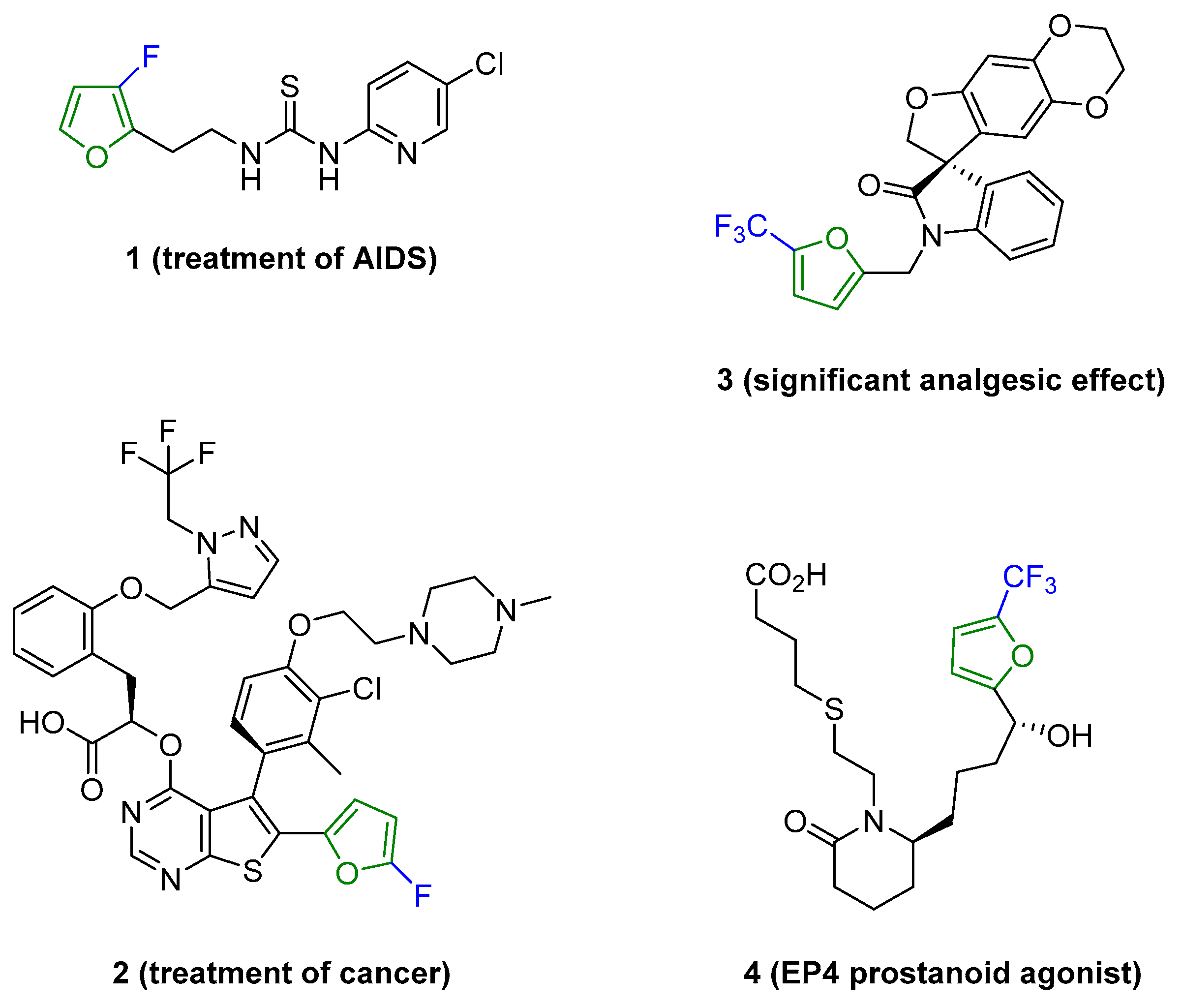
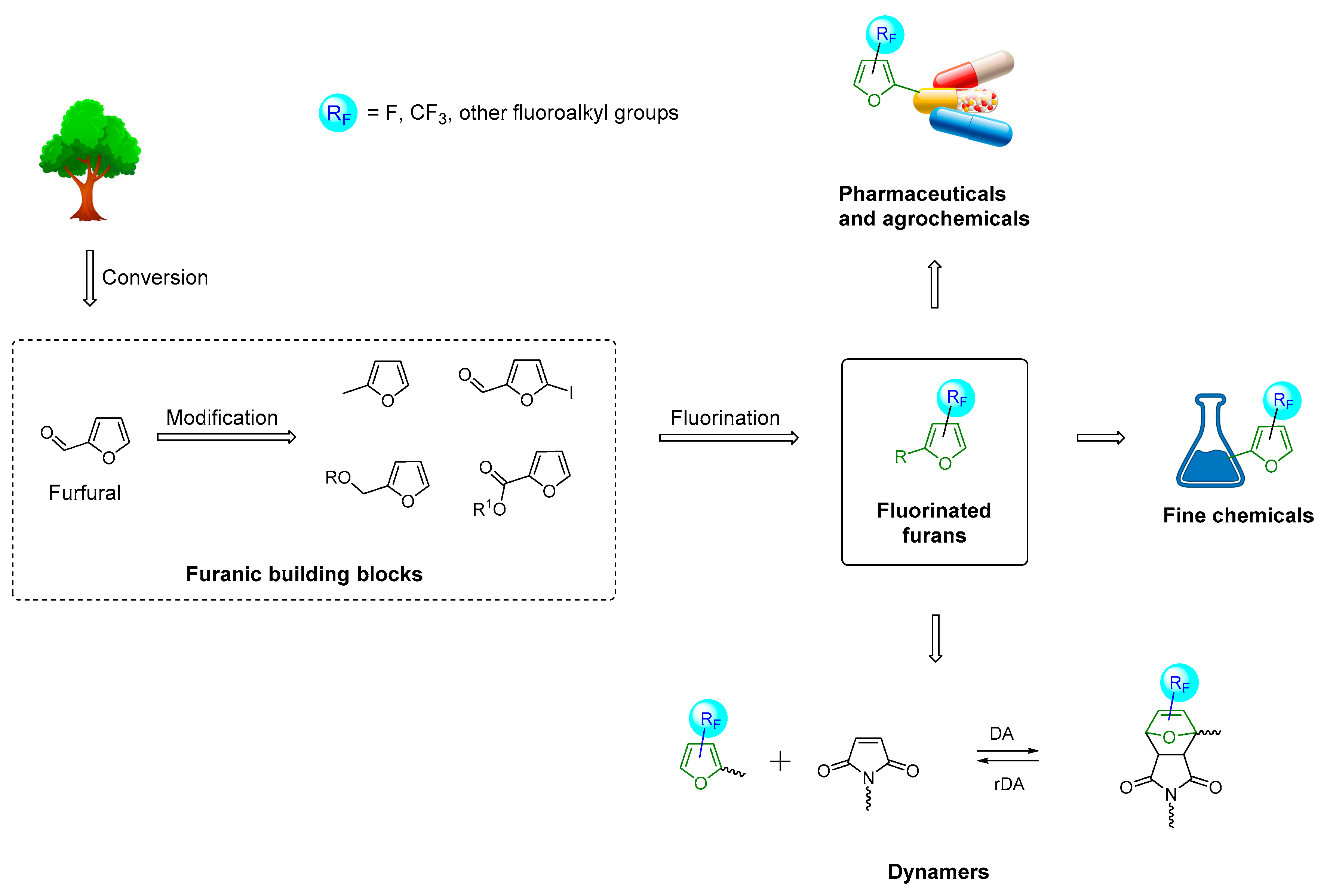
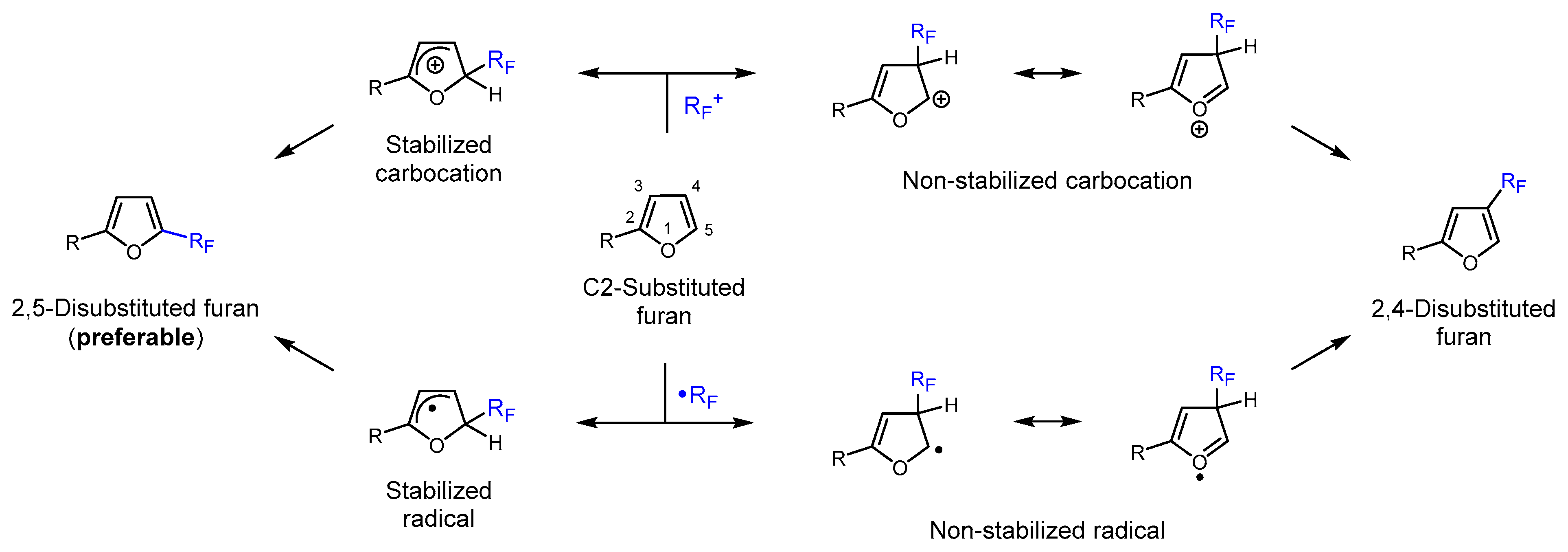
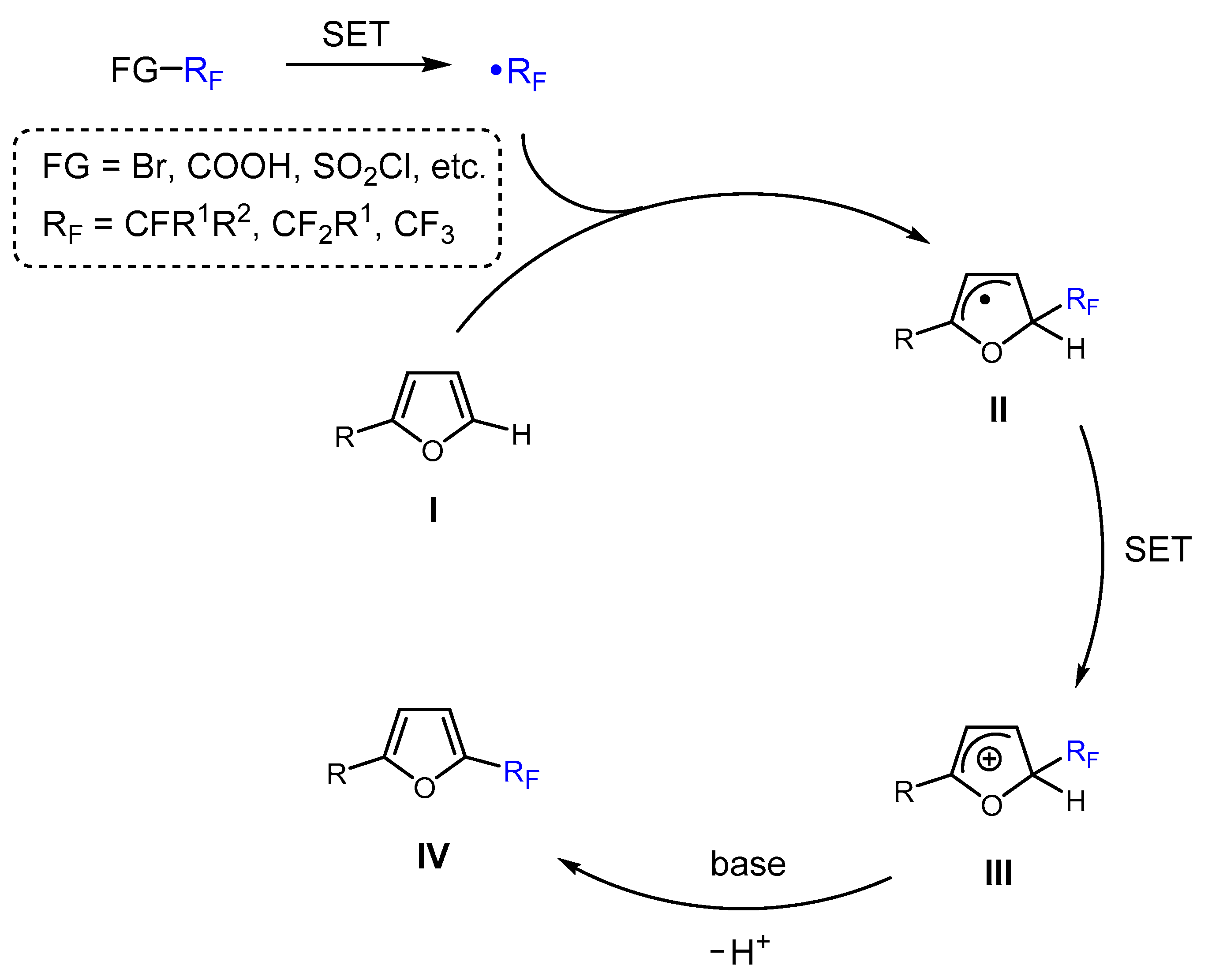
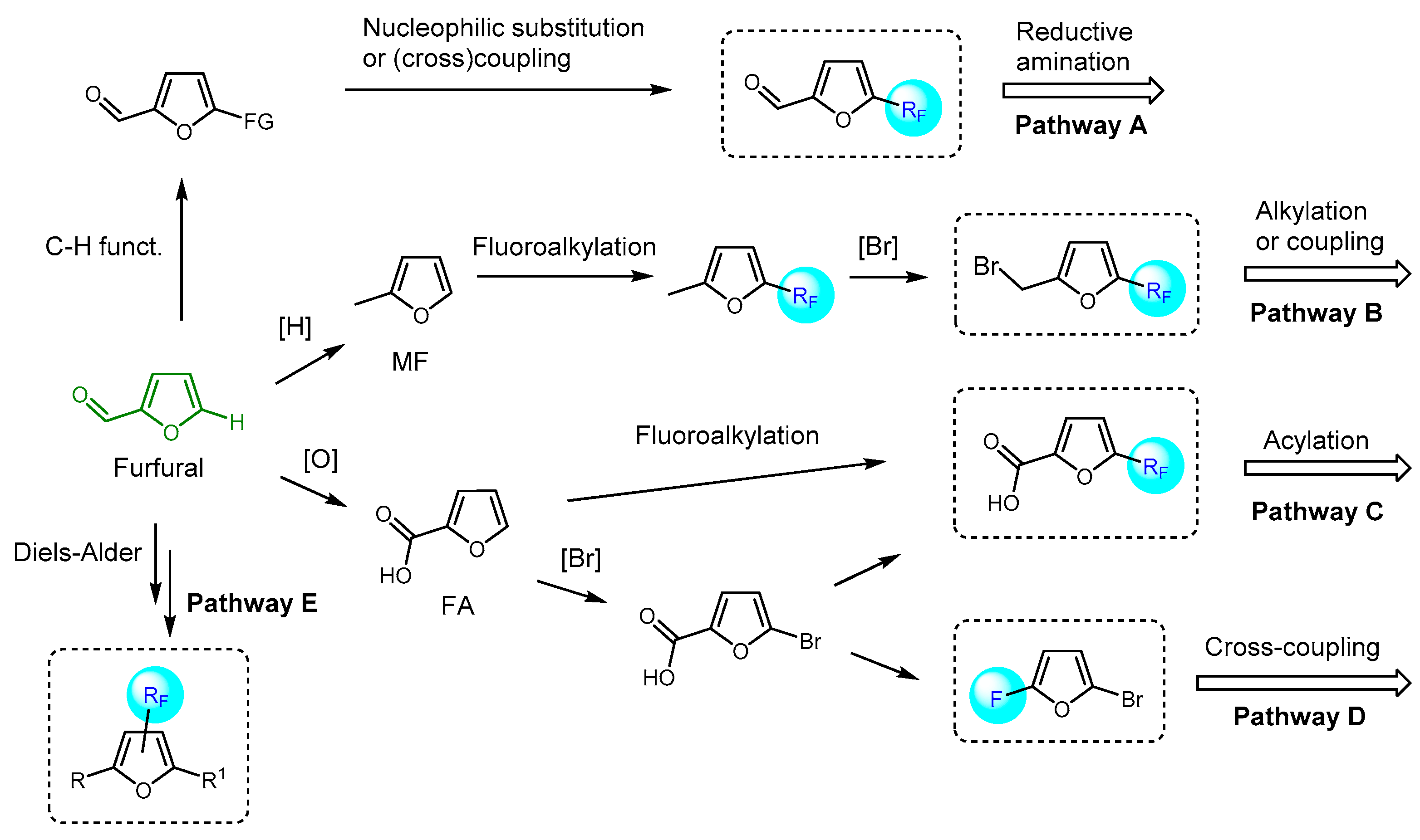
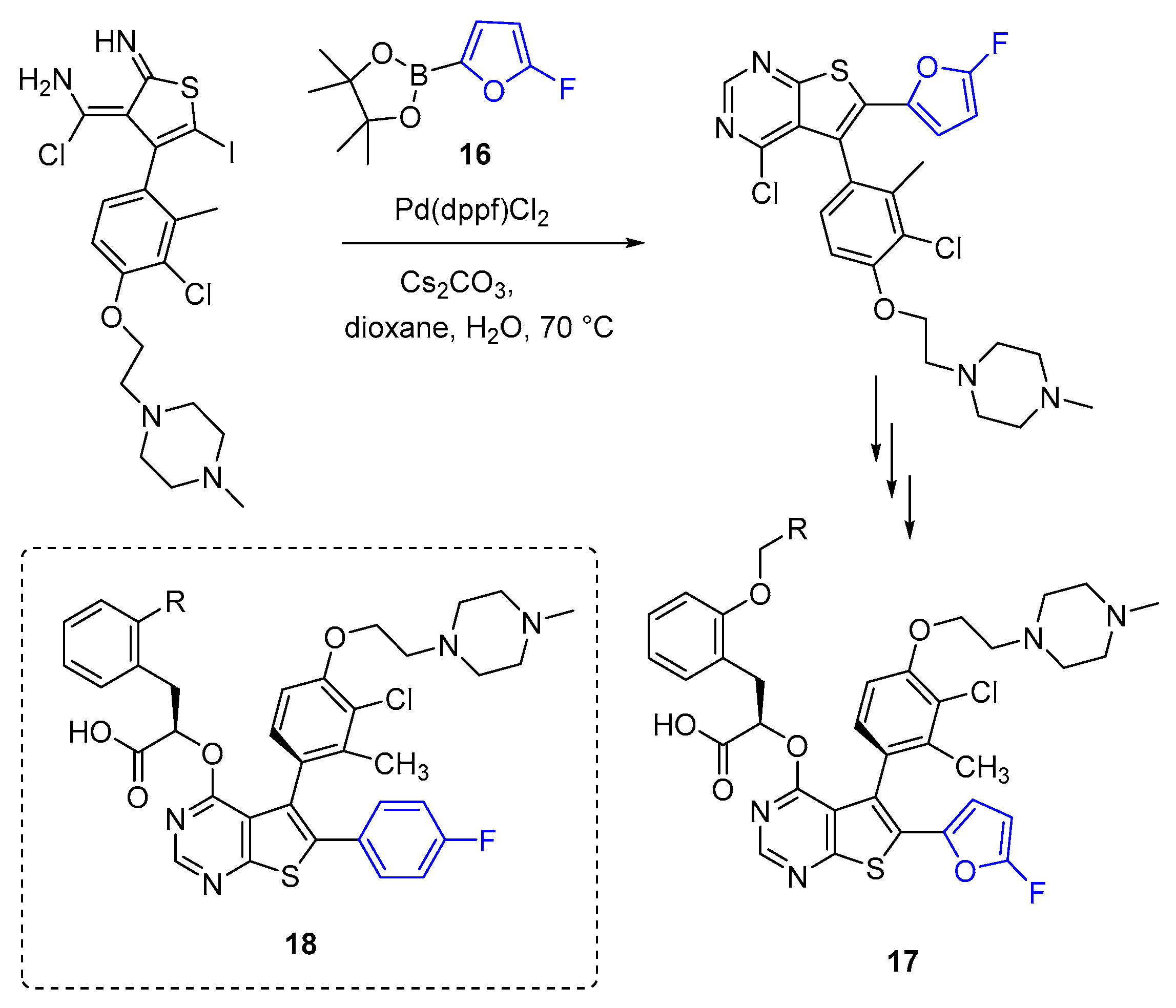
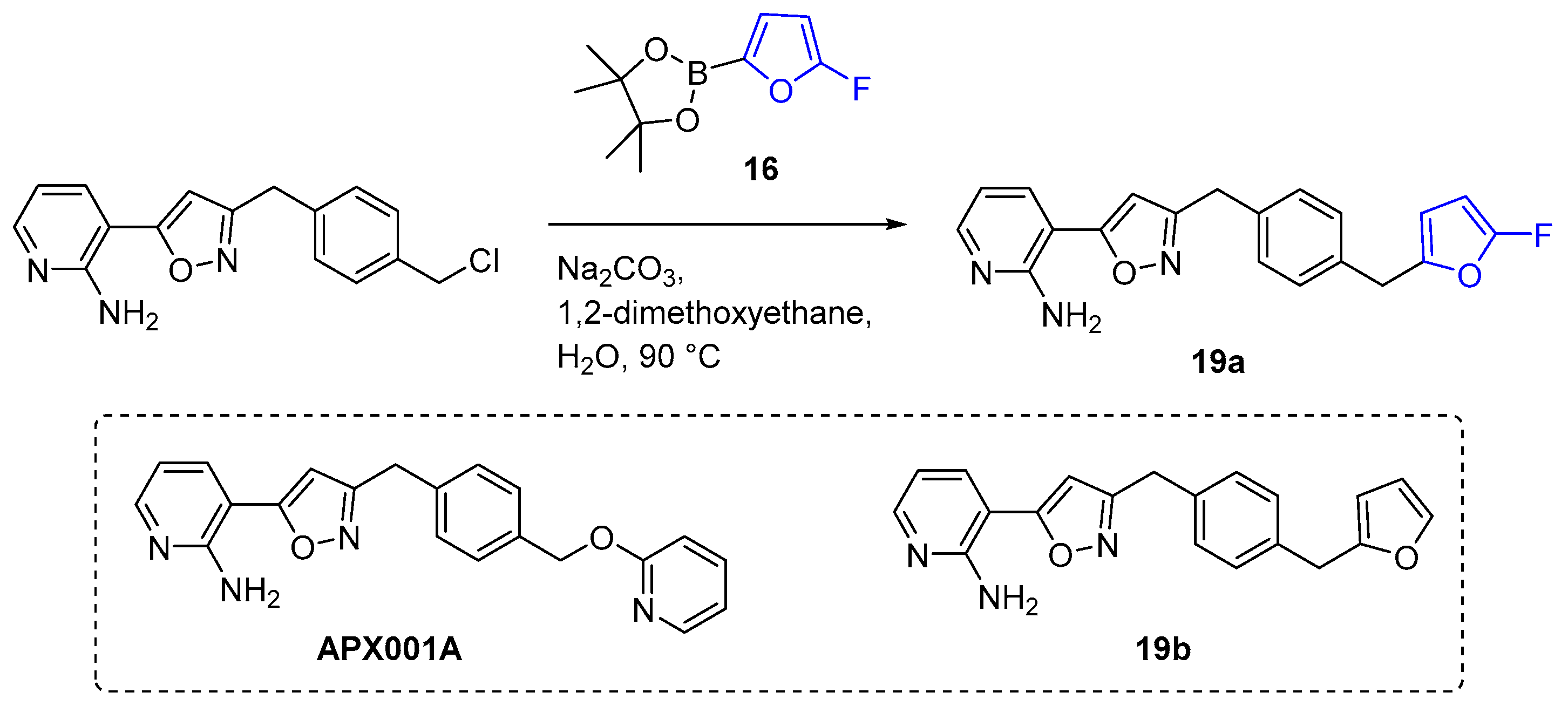
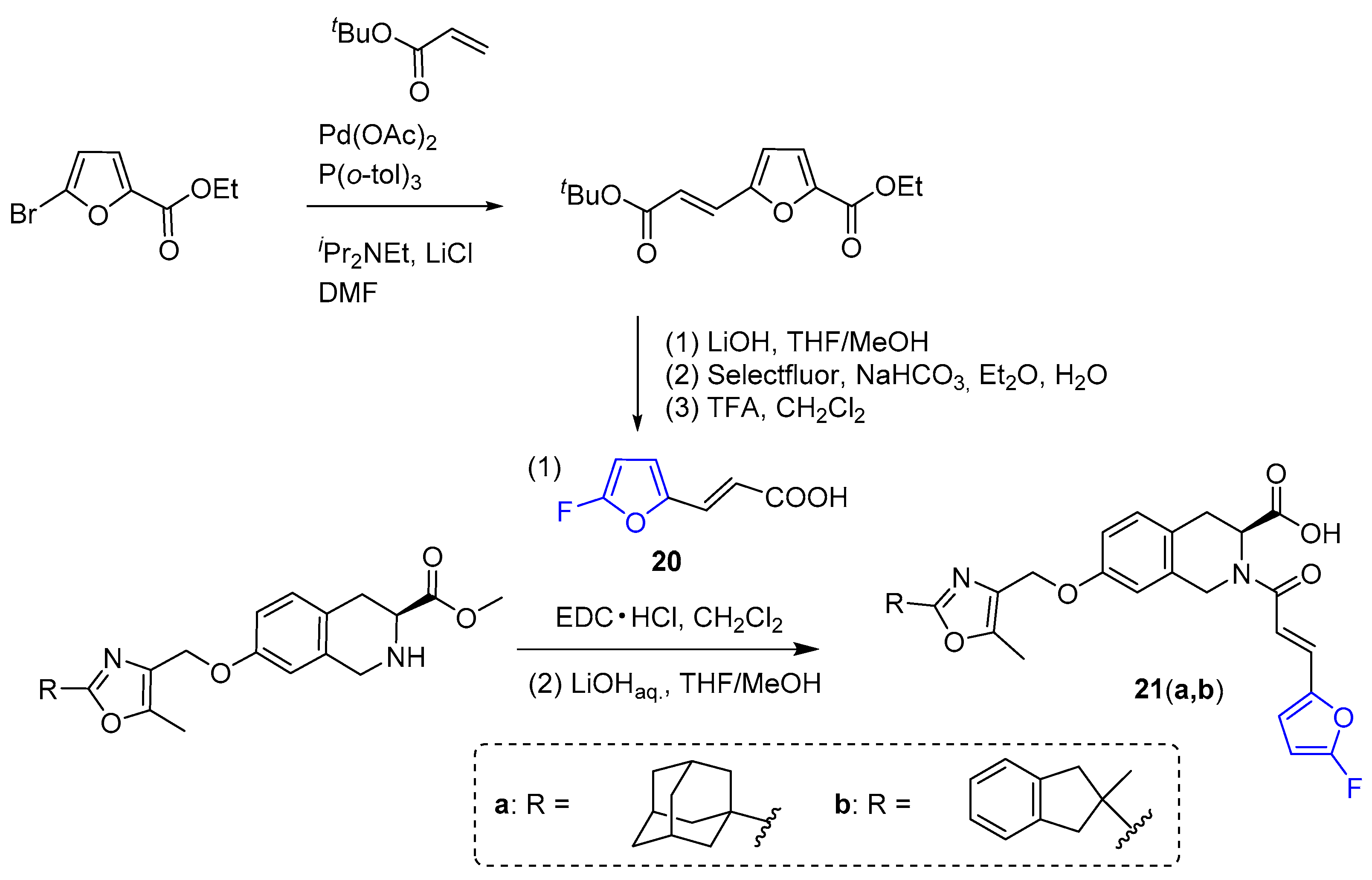


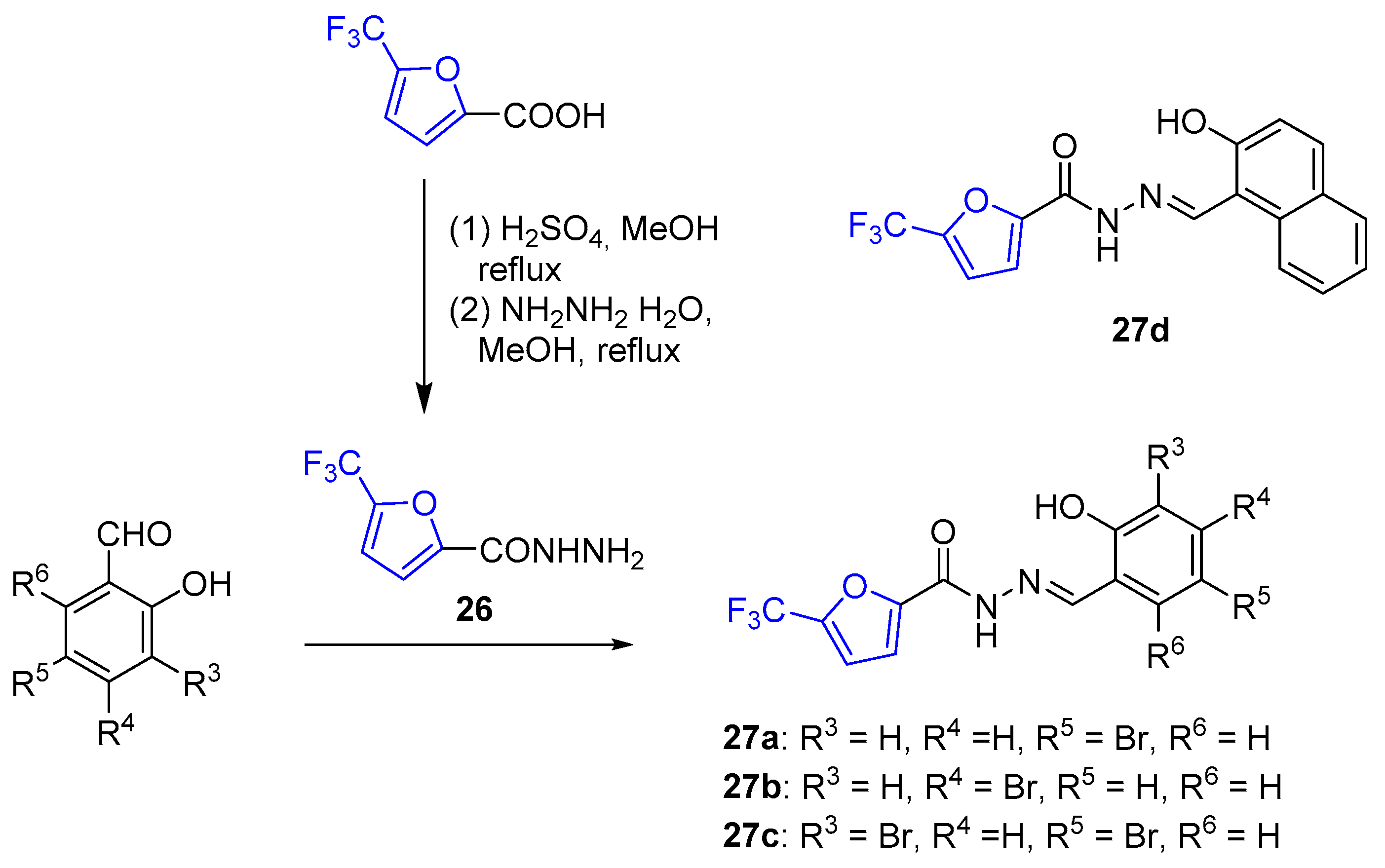
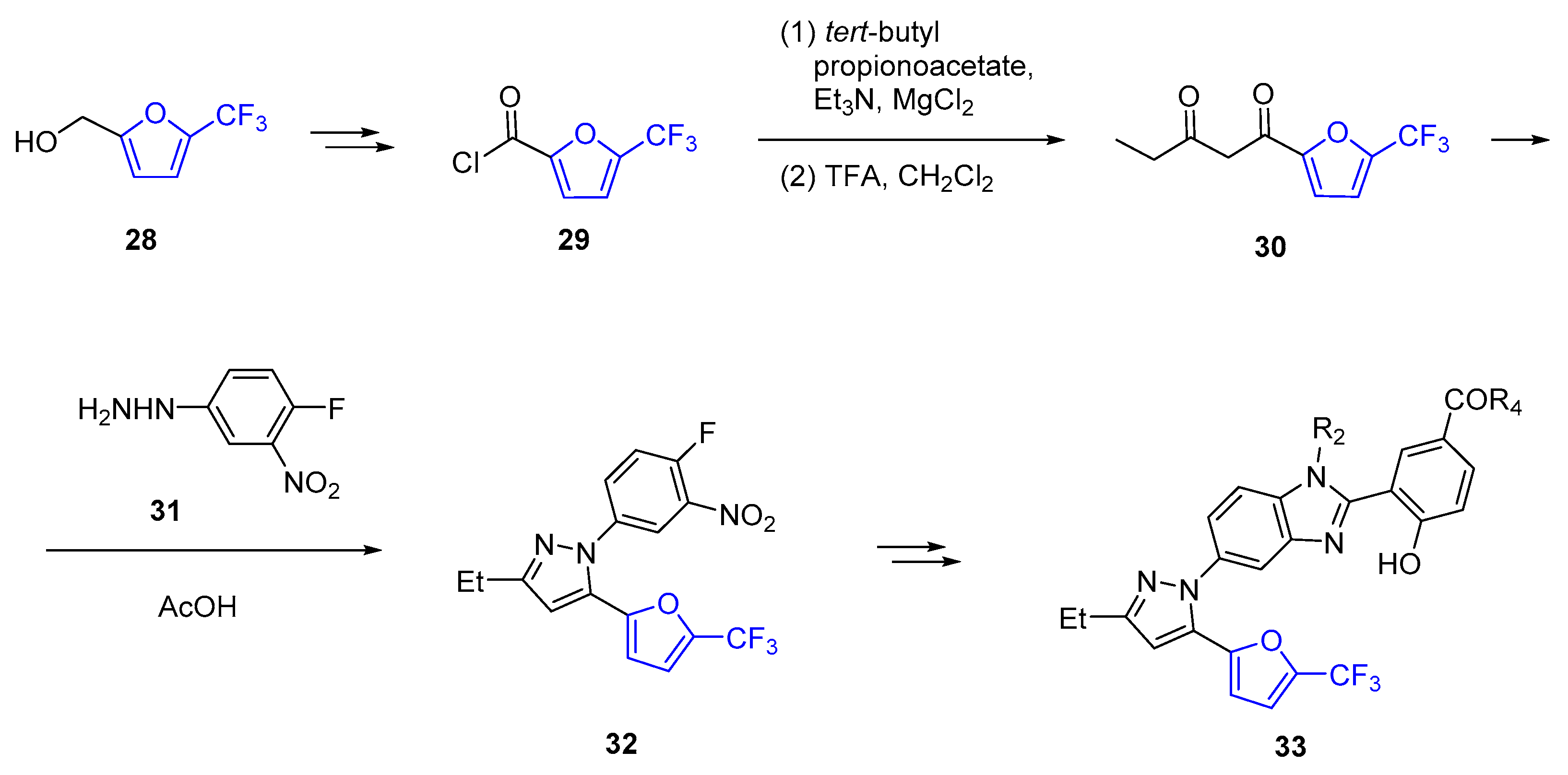
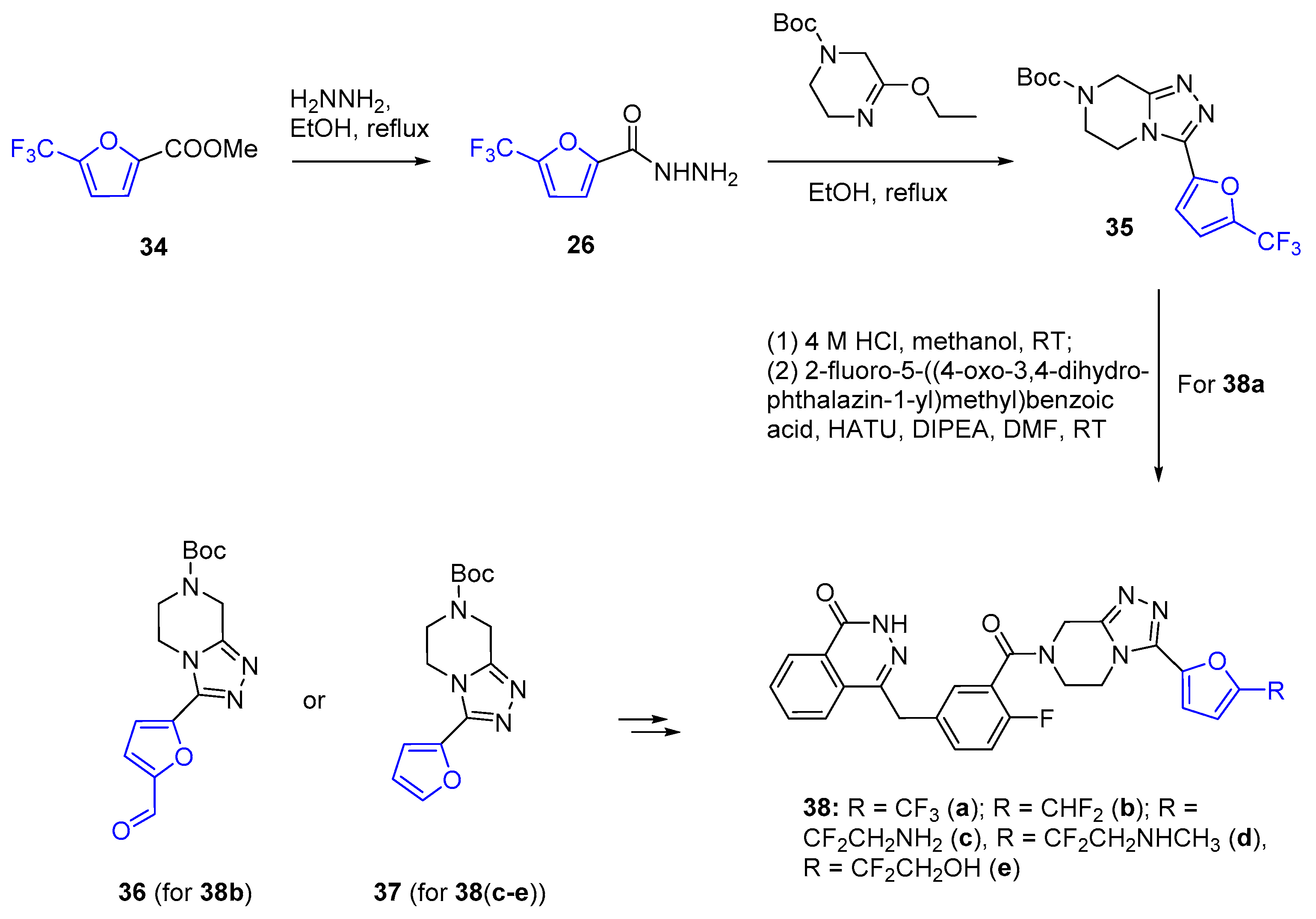
| № | Furanic Substrate | Reaction Conditions | Product | Yield (%) | Ref. |
|---|---|---|---|---|---|
| 1 |  | Selectfluor (1 eq.), CCl4/sat. NaHCO3 (2 eq.) |  | 27 | [115] |
| 2 |  | Selectfluor (2 eq.), KF (4 eq.), DCE/H2O (2:1), 70 °C |  | 57 | [116] |
| 3 |  | (1) KF, PPh4Br, sulfolane, 140 °C; (2) Pd/C, H2 (1 atm.), MeOH, RT |  | 56 | [78] |
| 4 |  |  (4 eq.), RhH(dppBz)2 (10 mol. %), PhCl, reflux (4 eq.), RhH(dppBz)2 (10 mol. %), PhCl, reflux |  | 53 | [118] |
 | ||||
| № | Substrate | Reaction Conditions | Product | Yield |
| 1 | 2-Methylfuran | 6 (1 eq.), THF, rocking furnace, 130 °C, 24 h | 7 | 86 |
| 2 | Furfural alcohol | 6, THF, rocking furnace, 130 °C, 24 h | 8 | 92 |
| 3 | 7 | H2, Pt/C, THF, then 400 °C | 9 | 89 |
| 4 | 8 | H2, Pt/C, THF, then 400 °C | 10 | 87 |
| 5 | Furfural | 5 (1.6 eq.), quartz tube, 225 °C, 24 h | 11 | 51 |
| 6 | 2-Furonitrile | 5 (1.5 eq.), quartz tube, 250 °C, 24 h | 12 | 71 + 21 1 |
| 7 | 2-Furoic acid | 5 (1.5 eq.), quartz tube, 300 °C, 24 h | 13 | 39 1 |
| 8 | Methyl 2-furoate | 5 (1.4 eq.), quartz tube, 250 °C, 24 h | 14 | 85 |
| 9 | Ethyl 2-furoate | 5 (1.5 eq.), quartz tube, 250 °C, 24 h | 15 | 89 |
Disclaimer/Publisher’s Note: The statements, opinions and data contained in all publications are solely those of the individual author(s) and contributor(s) and not of MDPI and/or the editor(s). MDPI and/or the editor(s) disclaim responsibility for any injury to people or property resulting from any ideas, methods, instructions or products referred to in the content. |
© 2025 by the authors. Licensee MDPI, Basel, Switzerland. This article is an open access article distributed under the terms and conditions of the Creative Commons Attribution (CC BY) license (https://creativecommons.org/licenses/by/4.0/).
Share and Cite
Galkin, K.I.; Sandulenko, I.V. Linking Fluorine with Bio-Derived Furfural: Aiming Towards More Sustainable Fluorinated Polymers and Drugs. Molecules 2025, 30, 2305. https://doi.org/10.3390/molecules30112305
Galkin KI, Sandulenko IV. Linking Fluorine with Bio-Derived Furfural: Aiming Towards More Sustainable Fluorinated Polymers and Drugs. Molecules. 2025; 30(11):2305. https://doi.org/10.3390/molecules30112305
Chicago/Turabian StyleGalkin, Konstantin I., and Irina V. Sandulenko. 2025. "Linking Fluorine with Bio-Derived Furfural: Aiming Towards More Sustainable Fluorinated Polymers and Drugs" Molecules 30, no. 11: 2305. https://doi.org/10.3390/molecules30112305
APA StyleGalkin, K. I., & Sandulenko, I. V. (2025). Linking Fluorine with Bio-Derived Furfural: Aiming Towards More Sustainable Fluorinated Polymers and Drugs. Molecules, 30(11), 2305. https://doi.org/10.3390/molecules30112305







